Our 2019 annual report analysing trends and highlighting risks in electrical and gas accidents.
Download:
Executive summary
Overview of 2019
During 2019, 12 notifiable and 21 non-notifiable accidents1 in New Zealand were reported to WorkSafe’s Energy Safety team comprising of:
- three electrical notifiable accidents (non-fire) which injured three people
- no notifiable but 13 non-notifiable natural gas accidents
- nine notifiable and eight non-notifiable LPG accidents which altogether resulted in injuries to nine people.
High-risk groups 1993–2019
Since 1993, electrical and gas (natural and LPG) accidents in New Zealand have been analysed according to high-risk groups to provide information about trends, frequency, common causes and severity.
Electrical accidents
The previously known general public accidents (1993–2008), and all public electrical accidents investigated since 2009 by Energy Safety, are aggregated as a single electrical accident category to enable analysis.
Two categories of particular interest are accidents involving young people and electrical safety in domestic residential environments.
Young people (17 years old and under)
Since 1993 young people were involved in 37% (104) of the total general public accidents (283), involving 17 fatalities and injury to 94 people.
Domestic environment
More than 54% of the accidents involving the general public in the last 27 years occurred in a domestic environment, resulting in 28 fatalities (58%) and injuries to 127 people (51%).
Natural gas accidents
In the last 27 years, a total of 207 notifiable natural gas accidents and 632 non-notifiable accidents were reported to us.
Equipment
Cookers and ovens
A total of 37 notifiable natural gas accidents (18%) involved cookers or ovens which resulted in one fatality and injury to 14 people.
Cookers and ovens accounted for 12% of reported non-notifiable natural gas accidents.
Space heaters
A total of 57 notifiable natural gas accidents were reported. Of these, 28% involved space heaters which resulted in three fatalities and injury to 13 people.
Space heaters accounted for 20% of reported non-notifiable accidents.
Water heaters and boilers
A total of 70 notifiable natural gas accidents reported involved water heaters or boilers (34%), resulting in one fatality and injury to 19 people.
Water heaters and boilers also accounted for 5% of reported non-notifiable accidents.
Liquefied Petroleum Gas (LPG)
In the last 27 years, a total of 442 notifiable LPG accidents and 572 non-notifiable accidents were reported to us.
Equipment
Cookers and ovens
Of the 442 notifiable LPG accidents reported, 128 (29%) involved cookers or ovens. Out of the 128 notifiable accidents involving cookers and ovens, 94 resulted in 17 fatalities and injury to 125 people.
Cookers and ovens accounted for 16% of reported non-notifiable LPG accidents.
Cabinet heaters
There were 143 (33%) notifiable LPG accidents reported that involved cabinet heaters. Out of these, 66 accidents resulted in 13 fatalities and injury to 67 people.
Cabinet heaters accounted for 30% of reported non-notifiable accidents.
Containers (refillable)
There were 27 (6%) notifiable accidents reported that involved LPG refillable containers. This resulted in 16 container accidents that caused four fatalities and injured 20 people.
Refillable containers accounted for 88 (15%) of reported non-notifiable accidents.
Environment
Caravans and campervans
There were 47 (11%) out of the 442 notifiable LPG accidents that occurred in caravans or campervans. Of these, 34 caused 11 fatalities and injured 40 people.
1.0 Background
Energy Safety is part of WorkSafe New Zealand – we are responsible for the administration of electricity and gas safety and related matters under the Gas Act 1992 and the Electricity Act 1992.
We aim to bring a clear focus on safety, supply quality and measurement across the electricity and gas sectors.
In January 2009, the responsibility for investigating and reporting on all worker and workplace related gas and electrical accidents was transferred from Energy Safety to the Labour Group (formerly the Department of Labour).
In 2013, Energy Safety became part of WorkSafe, and maintains their responsibility of conducting a range of functions under energy-related legislation. These include monitoring and enforcement, investigation of accidents related to gas and electricity, and the development and promulgation of safety standards and information.
We have printed annual summaries of notifiable accidents since 2001, covering a period from 1998. The summaries provided regulatory agencies and an analysis that highlights trends and risks. While the focus of the annual analyses has been on notifiable accidents, trends in non-notifiable accidents have also been examined.
In 2009 we replaced the printed annual summaries with an online version on a quarterly basis. The quarterly publications cover the notifiable accident investigations completed in that quarter. This annual report complements the quarterly accident summaries. They examine accident data and trends related to accidents that occurred in that year.
2.0 Accident data collection and recording
Energy Safety has to be notified of certain accidents.2
These are generally high consequence accidents. This obligation falls on participants in the energy industry in the first instance. Notifications of gas and electricity related accidents also come from consumers and other agencies, such as the Fire and Emergency New Zealand (FENZ) or through WorkSafe, or from a local body of Health and Safety Inspectors.
We investigate accidents and record at least a basic set of data on all reported accidents, regardless of the scale of the investigation. In general, more comprehensive information is recorded for the more intensive investigations that follow significant accidents.
As there is no obligation, and no rationale that is consistently applied for industry or industry sectors to report non-notifiable accidents to us, a low proportion of these accidents are reported.
We do not in general, conduct in-depth investigations of electrically-caused fires unless there is evidence of equipment failure. This is because a significant number of fires that are related to the supply or uses of electricity are either not reported or are not reported in a timely manner. Consequently this does not allow for a meaningful investigation to be completed. In any case, many electrical fires, although covered by the Electricity Act 1992, occur from incorrect operation or misuse of electrical equipment.
The definitions of ‘accident’ are similar in the Electricity Act 1992 and the Gas Act 1992. However there are significant differences in the collection and recording of electrical and gas accident data that affect the analysis of accidents and trends:
- Electrically-related fires are excluded from our As outlined above, there is evidence that there has historically been under-reporting to Energy Safety of less significant electrically-related fires. In addition our focus has been on electrical accidents3 other than fire.
- Energy Safety investigates and records gas-related accidents that involve fire, explosion, or gas ‘poisoning’4 Only those accidents that involve deliberate inhalation of LPG are excluded from our anaylsis.
- The electrical accident database in use up until 2008 allowed investigators to record only one likely major cause for an electrical The database used for gas investigations allowed investigators to record up to four likely causes or factors for a gas-related accident. The accident investigation database that has been in use since the beginning of 2008 allows a range of factors to be considered and identified.
- Natural gas and liquefied petroleum gas (LPG) have different characteristics as fuels and differing distribution and utilisation patterns so they are recorded and analysed separately.
- The gas accident database contains information about fatalities, injuries, fires, explosions and minor accidents for natural gas and These accidents have been analysed for severity5 and frequency of similar types of accidents.
2.1 Accident analysis
To identify trends and risk areas, this report examines data collected since 1993 on notifiable electrical accidents (other than fires) and both notifiable and non-notifiable gas accidents.
Since the implementation of the Electricity Act 1992 and the Gas Act 1992 came into force, comparisons have been made between five year periods.
This report includes the latest information available at the time of preparation. In some cases, the investigations are complex and may not have been completed at the time of publication. This means that each annual analysis has to review previous years’ cases when further information has been obtained.
This report does not set out to explain the reasons behind the trends and variations found. These trends may be influenced by any number of factors, including changes in the way accidents are reported, reporting level, or some improvements in safety or safety practices. Establishing the reason behind these trends would require a more detailed analysis of comprehensive data that is not always available and some of which may or may not exist.
We use a system called Energy Safety Intelligence (ESI), which was introduced at the beginning of 2008. This system integrates case management of electricity and gas operational activities, and stores electricity and gas accident information in a single database. This system has more data fields and a more consistent classification facility than was previously used.
3.0 Electrical accidents
Notifiable electrical accidents (non-fire) reported to us.
In a typical non-fire electrical accident, the victim receives an electric shock which requires medical treatment. In general these accidents are due to coming into proximity or contact with live electric lines, equipment or components. Note: Fire-related electrical accidents and accidents that involve workers are not included in this analysis.
Electrical accidents prior to 1 January 2009 were categorised under three main occupational headings: electrical workers, workers in other (non-electrical) occupations, and the general public. Generally about 50% of accidents involved electrical workers, 30% involved workers in other occupations, and 20% involved members of the public.
A notifiable electrical accident, as defined by the Electricity Act 1992, was modified by the Health and Safety at Workplace Act in 2016.6 The threshold for the electrical notifiable accident was raised, so now a fewer number of electrical accidents is qualified as notifiable accidents.
This report examines accidents involving members of the public for 2019, and also gives an overview of the 27 year period from 1993 to 2017.
It also compares rolling averages for the five-year base period (1993–1997) and the current five-year period (2015–2019).
One area of interest for electrical safety is protection of young people and the elderly. This section examines the number of accidents involving young people up to 17 years old and elderly people over 65.
3.1 Current trends
During 2019:
- There were no fatal electrical accidents and three notifiable accidents resulting in injury. Over the past 27 years there has been an average of 1.8 fatalities per year.
- The three accidents resulting in an injury affected three people. Over the past 27 years the average was 8.9 notifiable accidents per year.
- Two of these notifiable accidents involved the standard low voltage system of 230 volt (V). The average number of notifiable accidents involving 230V systems over the past 27 years is 5.9 per year.
3.2 Longer term trends
Observations based on analysis of trends, consequence, and frequency for the 27 year period between 1993 and 2019:
- There were 283 accidents involving members of the public which resulted in fatalities or injuries to 299 people (see Table 1: Notifiable electrical accidents and casualties).
- 48 of these were fatal accidents, each of which involved a single In six of the fatal accidents there was at least one other person injured.
- There were 241 injury accidents causing injury to a total of 251 people.
- Figure 1a shows considerable year-on-year variation in the number of fatal and injury accidents and there is no obvious significant trend in the annual number of fatal and injury accidents in this period. A five year rolling average accident number shows some reduction over the last 27 years.
- 111 (37%) of the total 299 victims are young people (under 17), see Figure 1b.
| Number of accidents | Number of casualties | |
|---|---|---|
| Fatality | 42 | 42 |
| Fatality and injury | 6 | 13 |
| Injury | 232 | 244 |
| Total | 283 | 299 |
Table 1: Notifiable electrical accidents and casualties
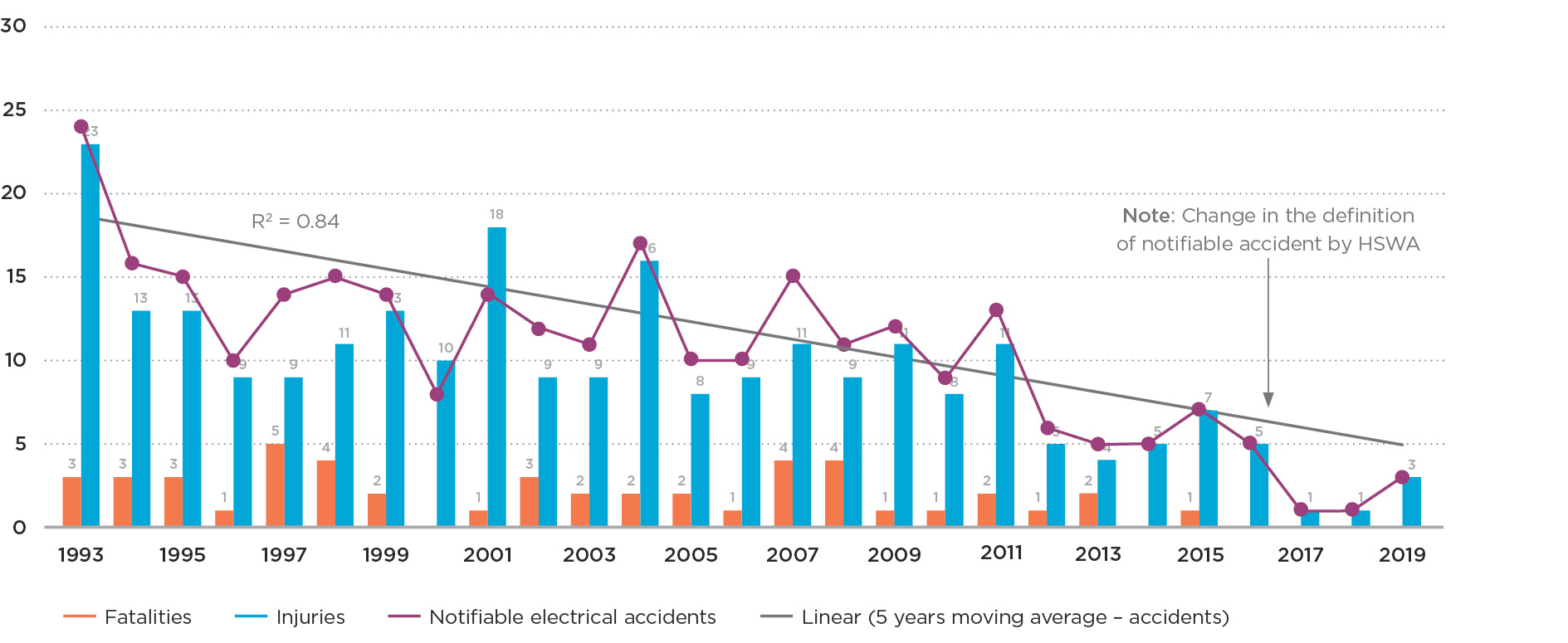
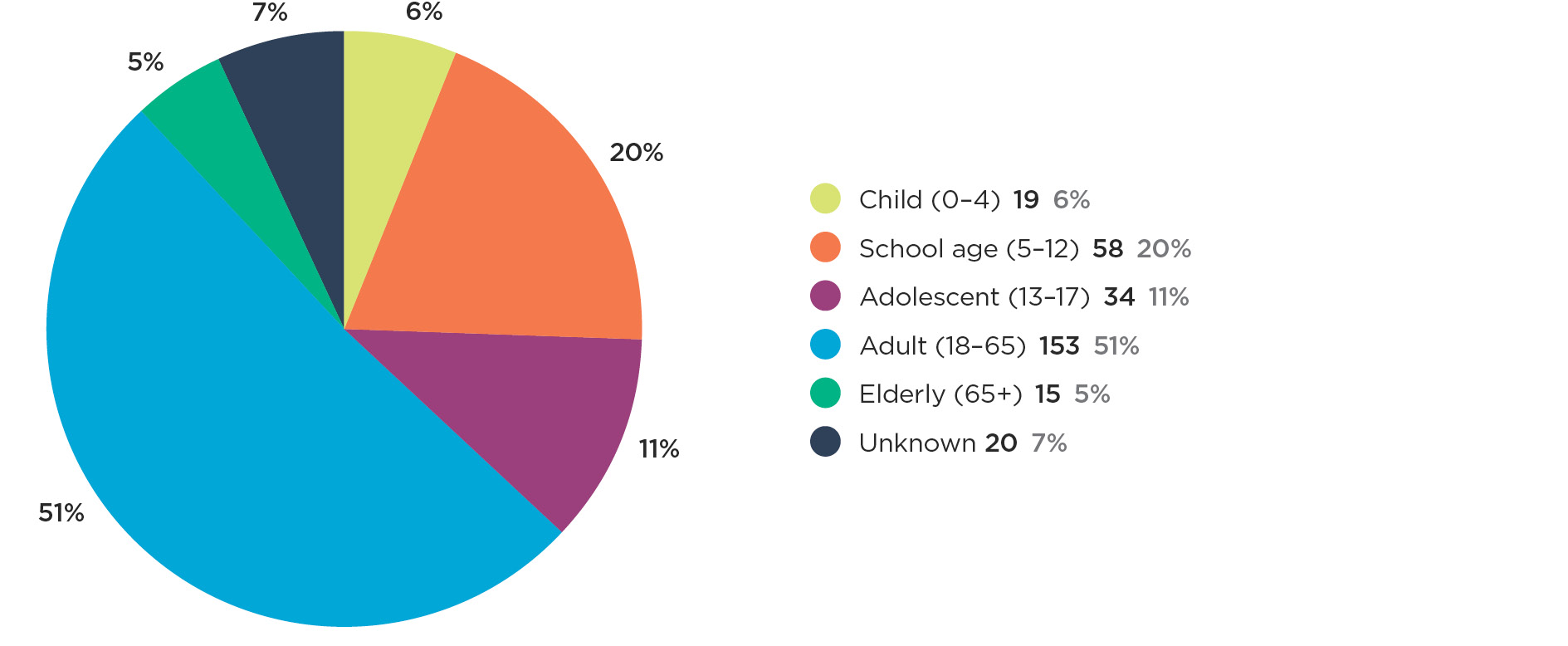
3.3 Age group
Accident data includes the general age group of involved parties (see Table 2) where it is known, or a reasonable estimate can be made.
| Fatal | Injury | |||
|---|---|---|---|---|
| Age groups | Consequence7 (frequency) 1993-2019 |
Consequence (frequency) 2015-2019 |
Consequence (frequency) 1993-2019 |
Consequence (frequency) 2015-2019 |
| Young people (0-17) | 17 (17) | 0 (0) | 94 (87) | 5 (5) |
| Child (0-4) | 4 (4) | 0 (0) | 15 (13) | 2 (2) |
| School age (5-12) | 5 (5) | 0 (0) | 53 (52) | 2 (2) |
| Adolescent (13-17) | 8 (8) | 0 (0) | 26 (22) | 1 (1) |
| Adult | 29 (29) | 1 (1) | 124 (123) | 10 (10) |
| Elderly (65+) | 2 (2) | 0 (0) | 13 (13) | 1 (1) |
| Total | 48 (48) | 1 (1) | 251 (241) | 17 (17) |
Table 2: Age breakdown for notifiable electric shock accidents involving members of the public
Our analysis shows:
- 35% of fatal accidents (17 fatalities) involved young people. The last fatal accident for this age group occurred seven years ago.
- 87 injury accidents involved 94 young people and five of these accidents, injuring five, occurred in the last five years.
- There has been a significant reduction in the number of young people who were injured in electrical accidents during the current period compared with the base period. In the current period, five (29%) out of 17 injuries involved young people compared with 30 (45%) out of 67 injuries in the base period.
- Only 5% (15) of the total 283 accidents involved people aged 65 years or This is a relatively small number compared with the age profile of the population as a whole. As numbers are small no further analysis has been carried out.
3.4 Voltage
Our analysis shows:
- The standard voltage in domestic installations is 230V. This is the voltage that people normally interact with in their homes. About two thirds of accidents involving members of the public involve 230V (see Figure 1c).
- 31 (65%) of the 48 fatal accidents and 158 (66%) of the 241 injury accidents involved 230V systems; two (4%) fatal accidents and 15 (6%) of injury accidents involved 400V systems; and eight (17%) of fatal accidents and 36 (15%) of injury accidents involved 11,000V systems (see Table 3).
- Of the 48 fatal accidents, 17 of the victims were young people. 11 of these cases involved 230V systems.
- 65 (35%) of the 187 fatal and injury accidents associated with 230V systems involved young people.
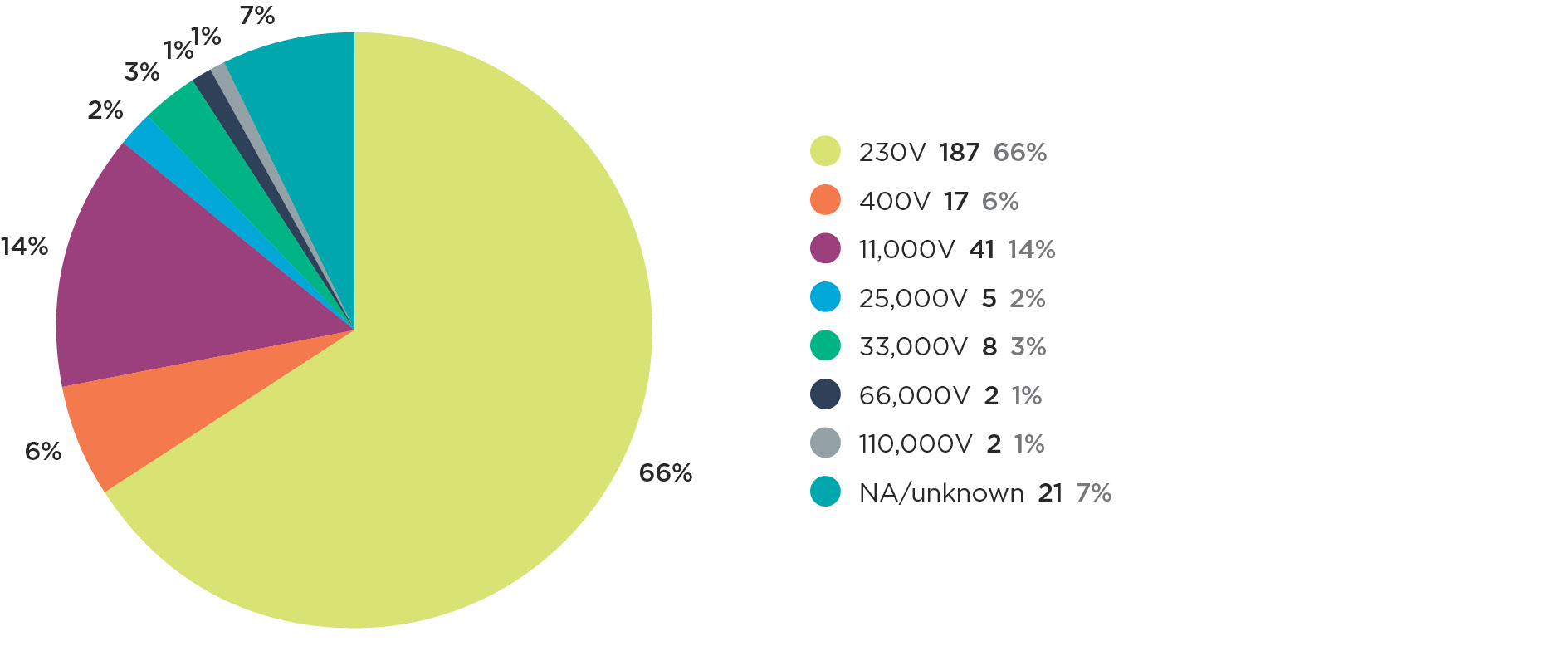
| Fatal | Injury | |||
|---|---|---|---|---|
| Voltage groups | Consequence8 (frequency) 1993-2019 |
Consequence (frequency) 2015-2019 |
Consequence (frequency) 1993-2019 |
Consequence (frequency) 1993-2019 |
| 230 | 31 (31) | 1 (1) | 160 (158) | 15 (15) |
| 400 | 2 (2) | 0 (0) | 15 (15) | 1 (1) |
| 11,000 | 8 (8) | 0 (0) | 38 (36) | 2 (2) |
| 25,000 | 2 (2) | 0 (0) | 3 (3) | 0 (0) |
| 33,000 | 2 (2) | 0 (0) | 7 (7) | 0 (0) |
| 66,000 | 1 (1) | 0 (0) | 1 (1) | 0 (0) |
| 110,000 | 0 (0) | 0 (0) | 6 (2) | 0 (0) |
| Total | 48 (48) | 1 (1) | 251 (241) | 17 (17) |
Table 3: Voltage breakdown for notifiable electric shock accidents involving members of the public
3.5 Causal factors
Our investigations seek to identify a causal factor(s). These factors fall into one or more broad categories as indicated in Figure 1d. Because there can be a combination of one or more causal factors for an accident, percentages do not add to 100%.
Our analysis shows:
- In cases involving members of the public the most common causes of electrical accidents were lack of maintenance in 65 cases (23%), and misuse actions in 46 cases (16%) (see Figure 1d).
- In 11 (23%) fatal electrical accidents, misuse of equipment was identified as the cause.
- Table 4 gives the most common causes of electrical accidents over the past 27 years, and over the past five years.
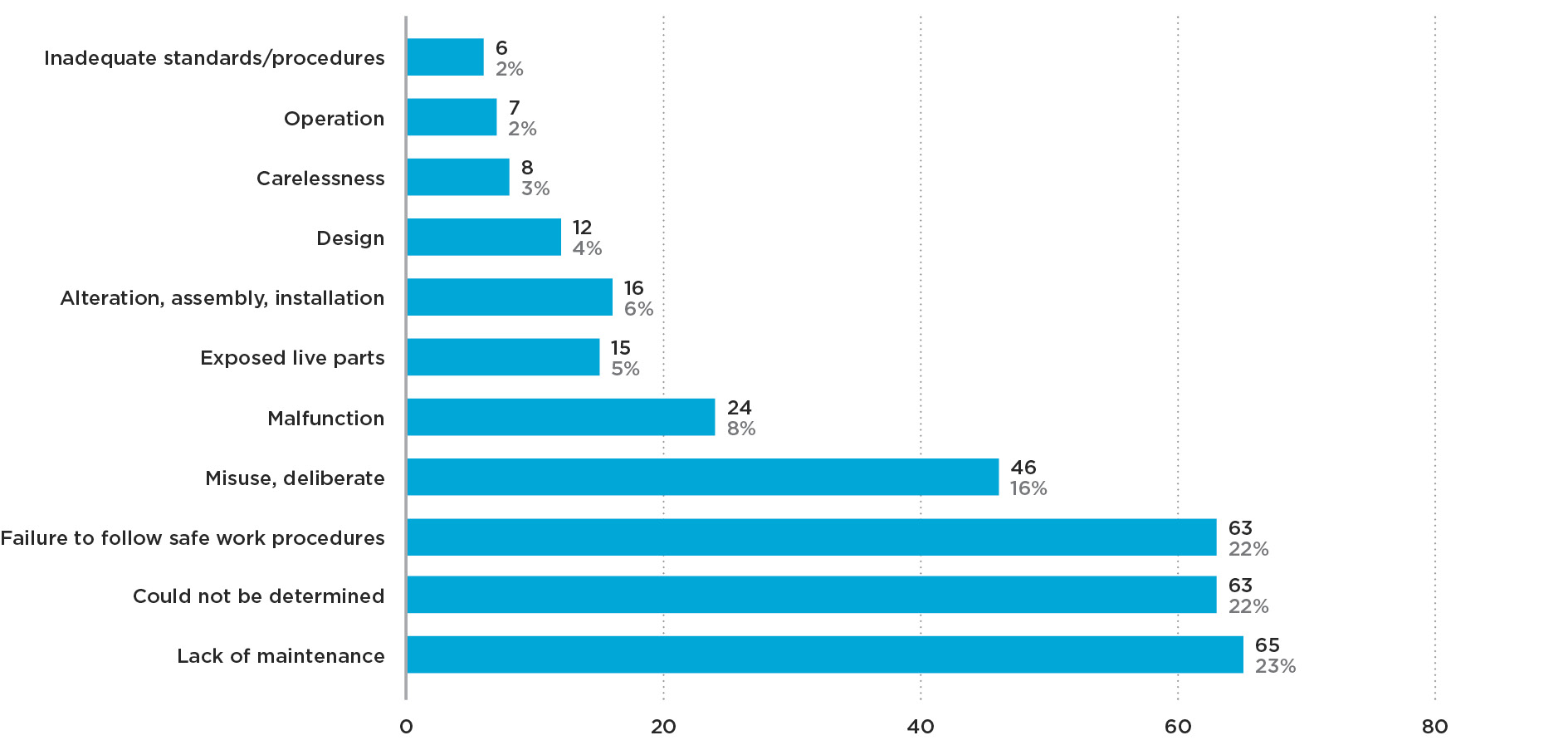
| Period 1993-2019 |
Period 2015-2019 |
|
|---|---|---|
| Main causes |
|
|
Table 4: Factors in notifiable electrical accidents involving members of the public
3.6 Equipment
Over 90% of accidents that involved members of the public were associated with one of five categories of equipment (see Figure 1e):
- appliances (26%)
- domestic installation wiring (19%)
- installation fittings9 (19%)
- works or distribution cable (19%)
- works distribution fittings (11%).
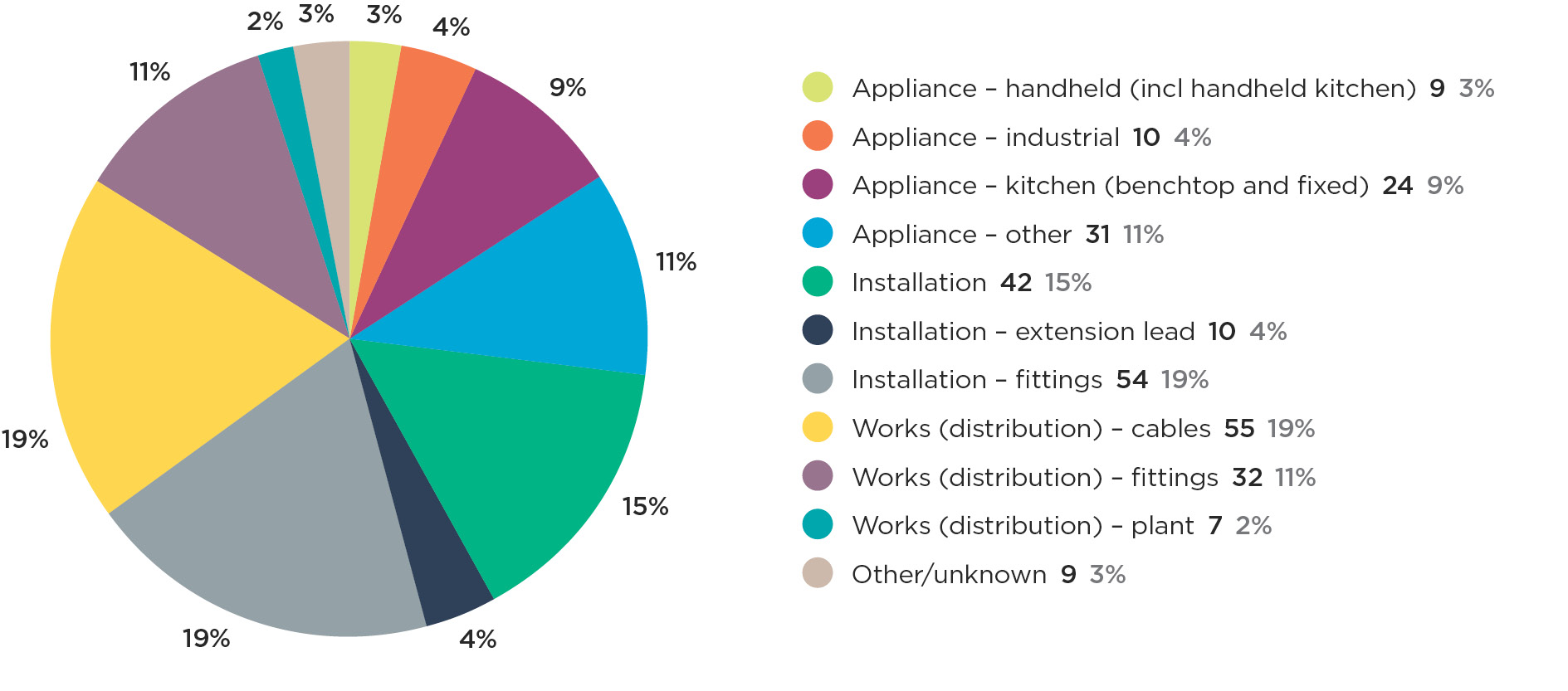
3.7 Environment
Figure 1f gives a more detailed breakdown of electrical accidents by environment type. Over half (54%) of the accidents occurred in the domestic environment. 17% of accidents occurred in the commercial environment and a similar level (17%) of accident occurred near works.
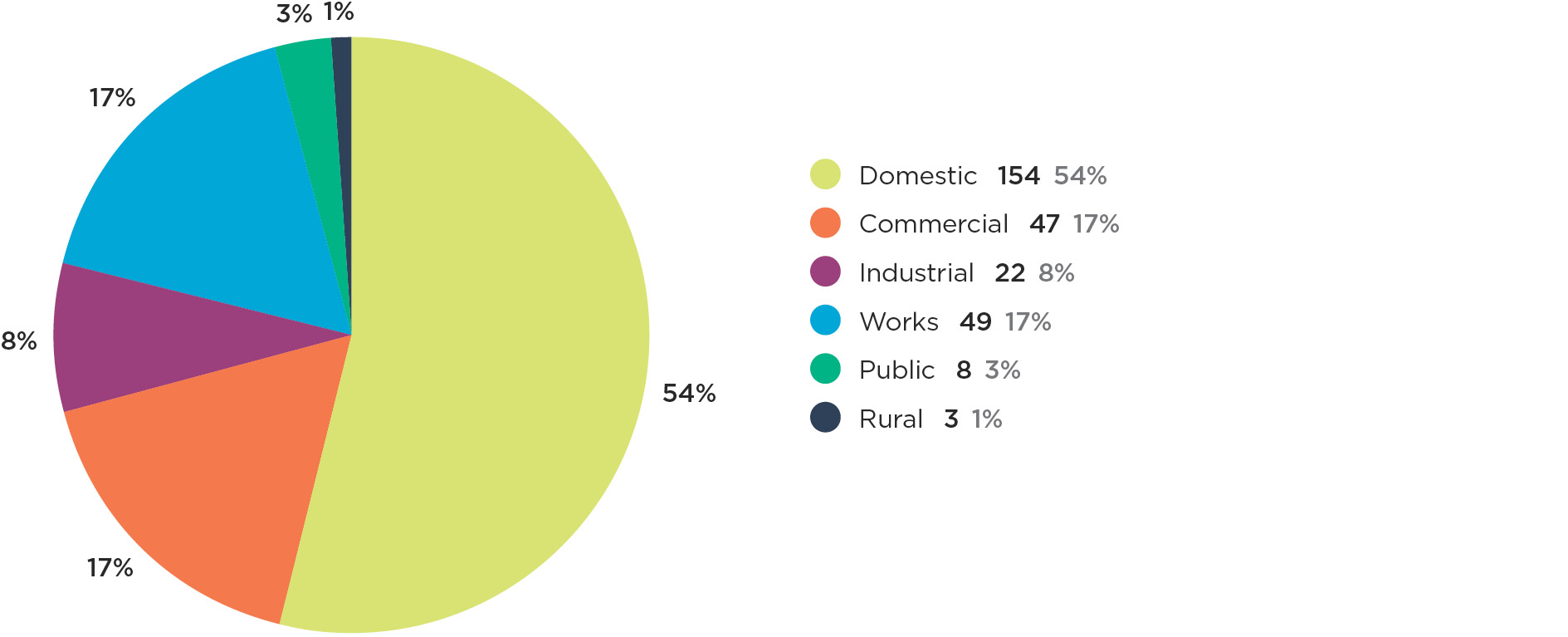
Our analysis shows:
- 28 (58%) of the 48 fatal accidents and 126 (52%) of the 241 injury accidents occurred in the domestic 230V domestic systems were involved in 26 of the 28 domestic environment fatal accidents and in 108 of the 126 injury accidents.
- 10 (21%) of the 48 fatal accidents and 42 (17%) of the injury accidents occurred in the work Three fatal and 23 injury accidents involved 11,000V systems.
4.0 Natural gas accidents
Notifiable and non-notifiable accidents (natural gas) reported to us.
We analyse natural gas-related accidents of all types, including fires and explosions, whether or not there were fatalities, or any loss related to property. All non-notifiable accidents, except for those reported in bulk,10 are included in this analysis.
This analysis examines accidents involving members of the public for 2019 and also for the 27 year period from 1993 to 2019. It includes a comparison between the base period (1993–1997) and the current five year period (2015–2019).
Historically data relating to gas accidents did not include the age of the victim. Recording data related to the age group of the victim for gas started with the introduction of an integrated case management system (ESI) in 2008. This section identifies general trends and examines general categories of appliances and other equipment involved in accidents.
4.1 Current trends
Analysis of notifiable gas accidents shows that during 2019:
- There was not a single notifiable natural gas accident (include injury and fatal) reported during year. This is the first the first time in the history of 27 years.
- In the past 27 years there have been 0.2 fatal accidents and 2.2 injury accidents per year on average.
- Thirteen non-notifiable accidents were reported. Three accidents each involved gas cookers, heaters; and installations, and two accidents each involving water heater and other appliances.
- Over the last four years, five non-notifiable distribution accidents (involving mains, services, and regulator stations etc) were reported after five years of nil accident reporting. The average distribution accident number over the first 18 years (1993–2010) was 16.7. A likely reason for a decline in distribution accident reporting to us was the transfer of responsibility for workplace accidents to investigate under workplace safety legislation (then Department of Labour) in 2009.
4.2 Longer term trends
Observations based on analysis of trends, consequence, and frequency for the 27 year period between 1993 and 2019:
- There were a total of 207 notifiable accidents. 145 (70%) of these were non-casualty accidents that resulted in property damage.
- There have been five fatal accidents (with five fatalities) and 59 injury – accidents injuring 72 people (see Figure 2a). With this small number spread over a 27 year period, it is not possible to identify a trend for fatal and injury accidents.
- The last fatal accident occurred in 2007. Fixed space heaters were involved
- in three of these fatal accidents, and cookers and water heaters were involved in one accident each.
- A total of 632 non-notifiable accidents were reported to Energy Safety.
- A reduction in non-notifiable accidents is observed over the last 14 years and a very clear downward trend is noticeable over the last eleven years (2009- 2019) (see Figure 2b).
- 46 non-notifiable accidents were reported in the last five years compared with 121 in the initial five-year period, a decrease of about two thirds (see Figure 2b). The notification of non-notifiable accidents related to gas distribution11 has dropped in the last eleven years.12
- The number of non-notifiable accidents reported by the gas industry has declined to 13 (2.6 per year) over the last five years compared to the base period 44 (8.8 per year). More non-notifiable gas distribution accidents were reported by the gas industry during 1998–2002 (18.0 per year) and 2003–2008 (15.3 per year) periods.
- 43% of non-notifiable accidents were reported to Energy Safety by the gas industry.
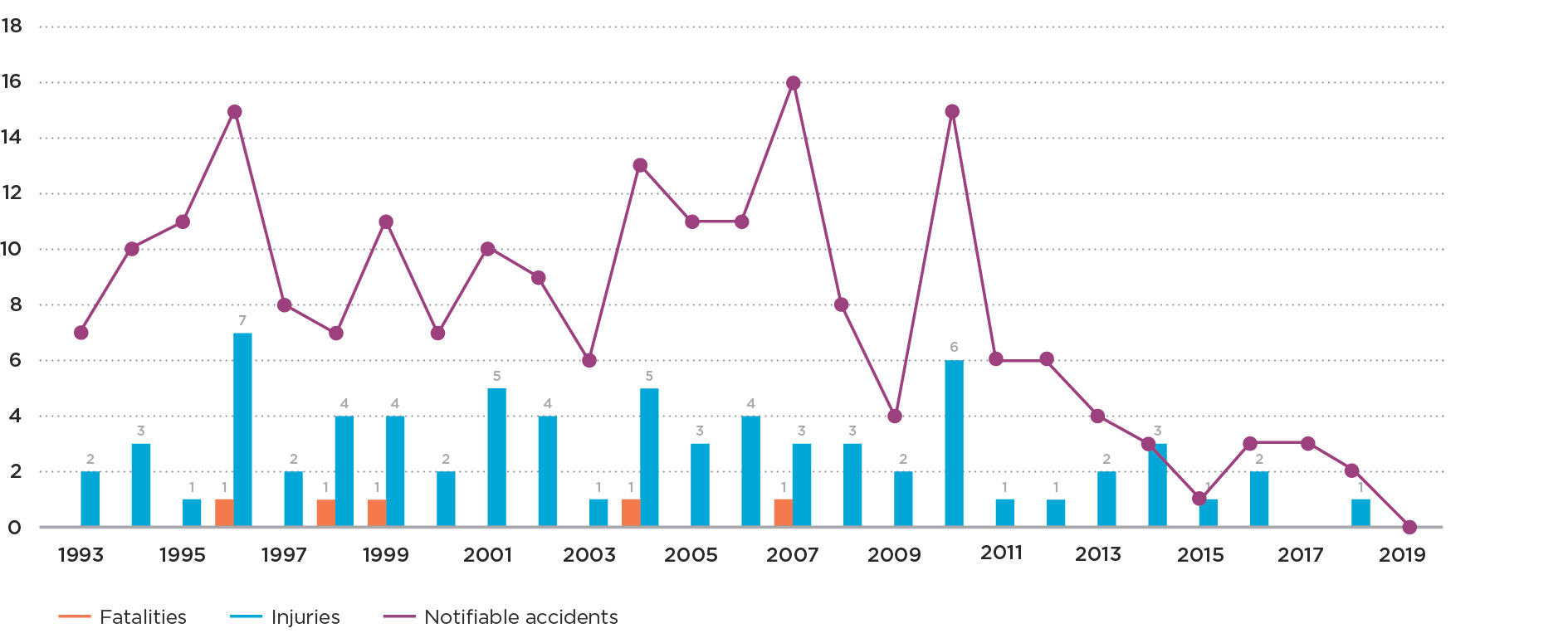
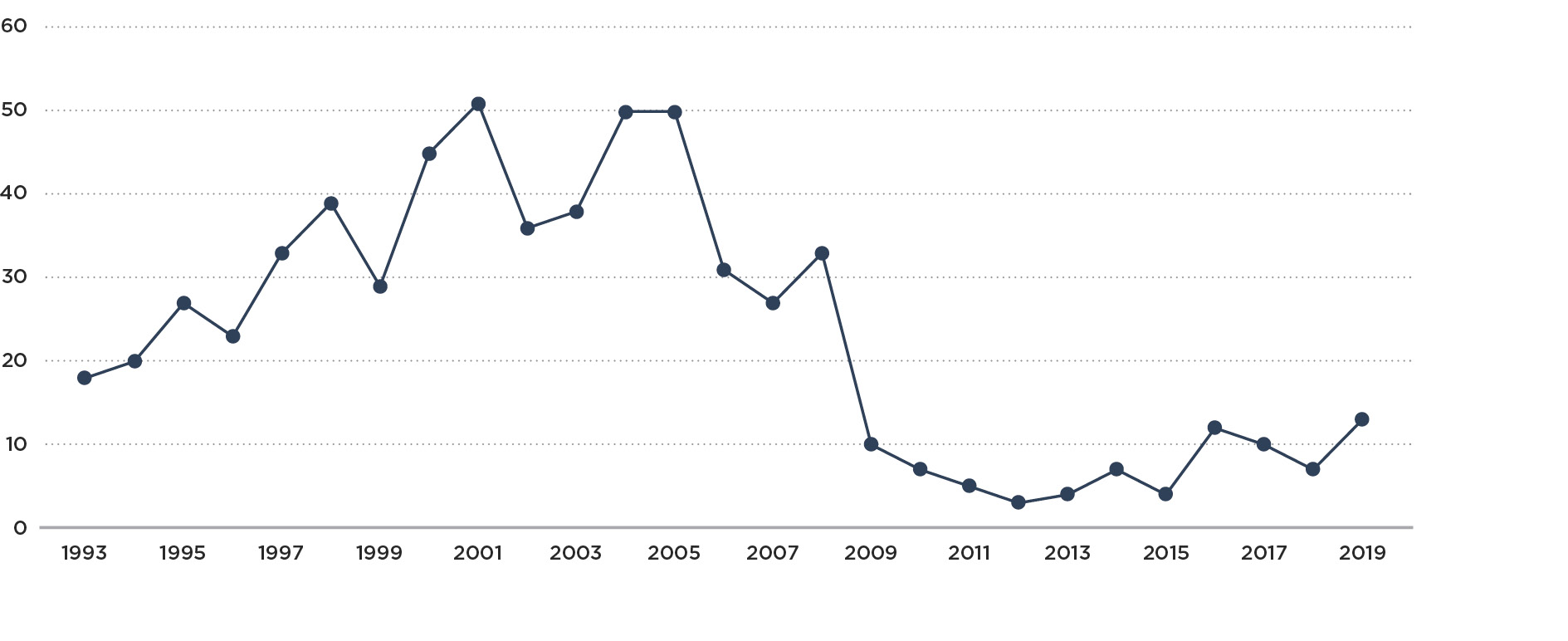
4.3 Causal factors
Table 5 gives the most common causes of notifiable natural gas accidents over the past 27 years, and over the past five years.
The most common causes13 identified of notifiable accidents over the last 27 years (see Figure 2c) were:
- assembly, connection, installation, alteration14– 71 (34%)
- lack of maintenance – 41 (20%)
- failure to follow appropriate procedure – 33 (16%)
- appliances too close to combustible products (proximity) – 28 (14%)
- work practices and third-party damage – 29 (14%).
| Period 1993-2019 |
Period 2015-2019 |
|
|---|---|---|
| Main causes |
|
|
Table 5: Factors in notifiable natural gas accidents involving members of the public
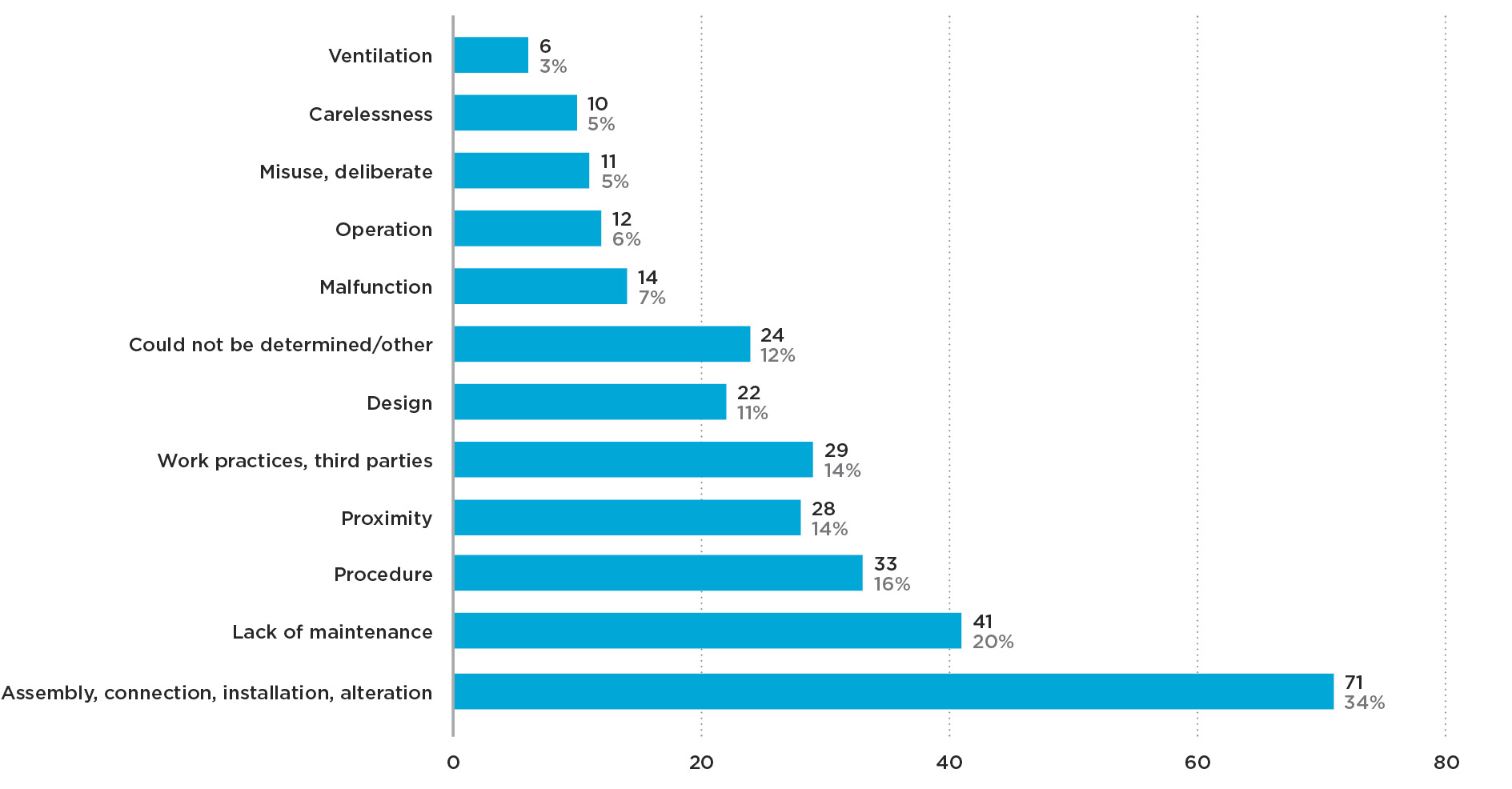
A third (200) of the non-notifiable accidents reported were caused by failure to follow correct work practices, including third-party incidents involving non-gas industry workers. 120 (19%) were caused by lack of maintenance, 72 (11%) by assembly, connection, installation, alteration15 and 85 (13%) by not following correct procedures (see Figure 2d).
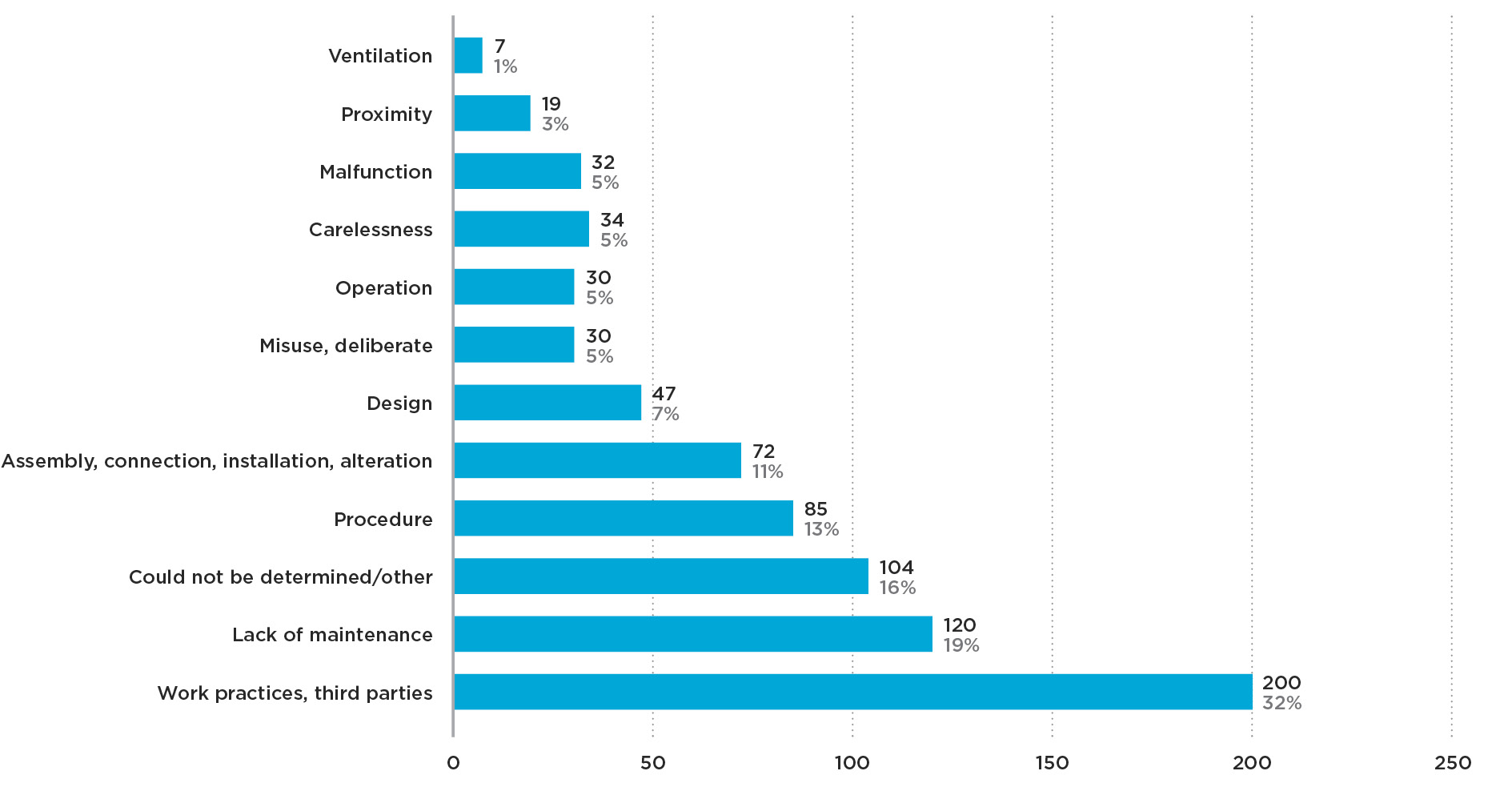
4.4 Equipment type
Table 6 and 7 give a more detailed breakdown of natural gas casualty and all natural gas accidents by equipment type. Three categories of appliance were involved in about 80% of notifiable accidents (see Figure 2e).
- Water heaters or boilers – 70 (34%).
- Space heaters – 57 (28%).
- Cooking appliances – 37 (18%).
About 90% of these accidents involved a fire or explosion.
| Fatal | Injury | |||
|---|---|---|---|---|
| Equipment type | Consequence16 (frequency) 1993-2019 |
Consequence (frequency) 2015-2019 |
Consequence (frequency) 1993-2019 |
Consequence (frequency) 2015-2019 |
| Cookers and ovens | 1 (1) | 0 (0) | 14 (11) | 0 (0) |
| Space heaters | 3 (3) | 0 (0) | 13 (12) | 1 (1) |
| Water heaters | 1 (1) | 0 (0) | 19 (16) | 3 (3) |
| Mains/service and regulator stations | 0 (0) | 0 (0) | 15 (12) | 0 (0) |
| Total | 5 (5) | 0 (0) | 72 (59) | 4 (4) |
Table 6: Breakdown of natural gas casualty accidents involving members of the public by equipment type
| Notifiable | Non-notifiable | |||
|---|---|---|---|---|
| Equipment type | Accidents17 (per year) 1993-2019 |
Accidents (per year) 2015-2019 |
Accidents (per year) 1993-2019 |
Accidents (per year) 2015-2019 |
| Cookers and ovens | 37 (1.4) | 0 (0) | 75 (2.8) | 12 (2.4) |
| Space heaters | 57 (2.1) | 2 (0.4) | 128 (4.7) | 14 (2.8) |
| Water heaters | 70 (2.6) | 6 (1.2) | 34 (1.3) | 4 (0.8) |
| Mains/service and regulator stations | 25 (0.9) | 0 (0) | 306 (11.0) | 5 (1.0) |
| Total | 207 (7.6) | 9 (1.8) | 632 (23.4) | 46 (9.2) |
Table 7: Breakdown of natural gas accidents involving members of the public by equipment type
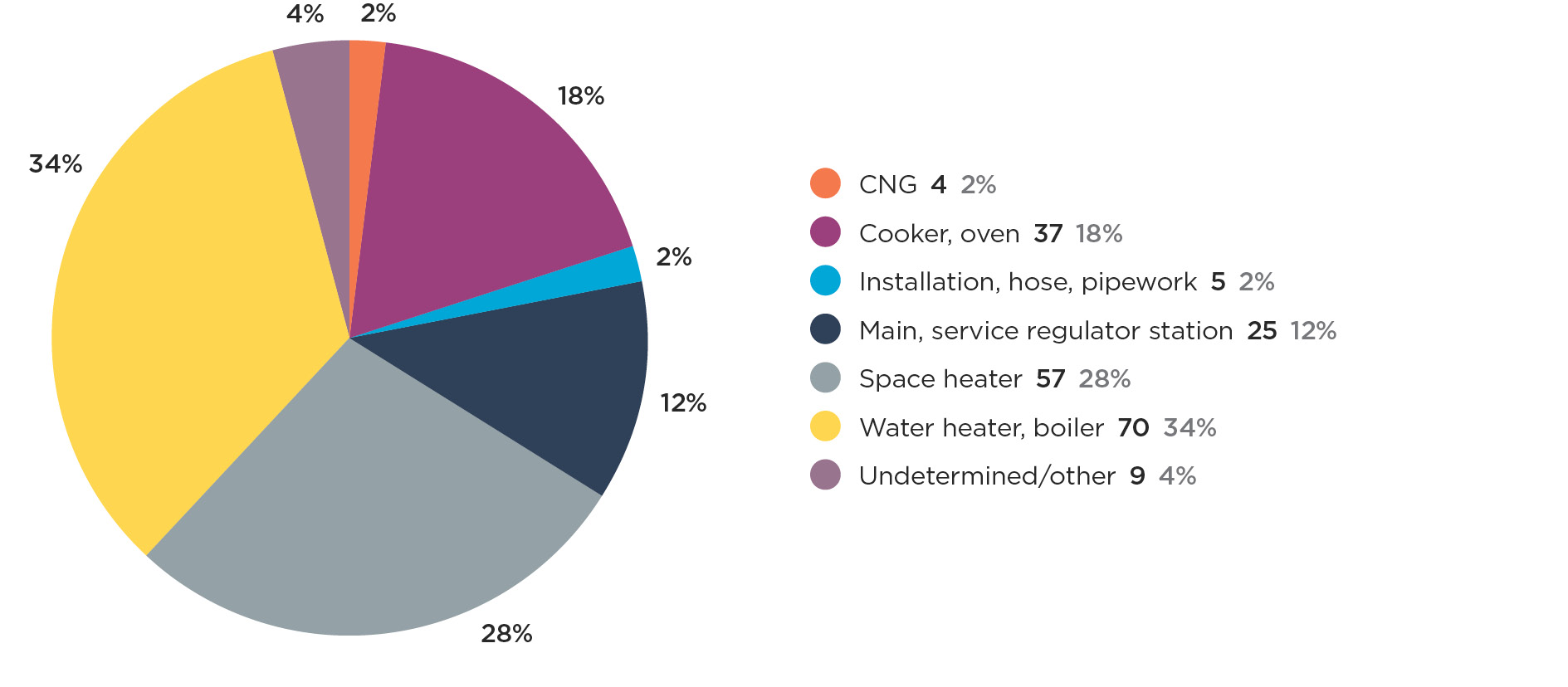
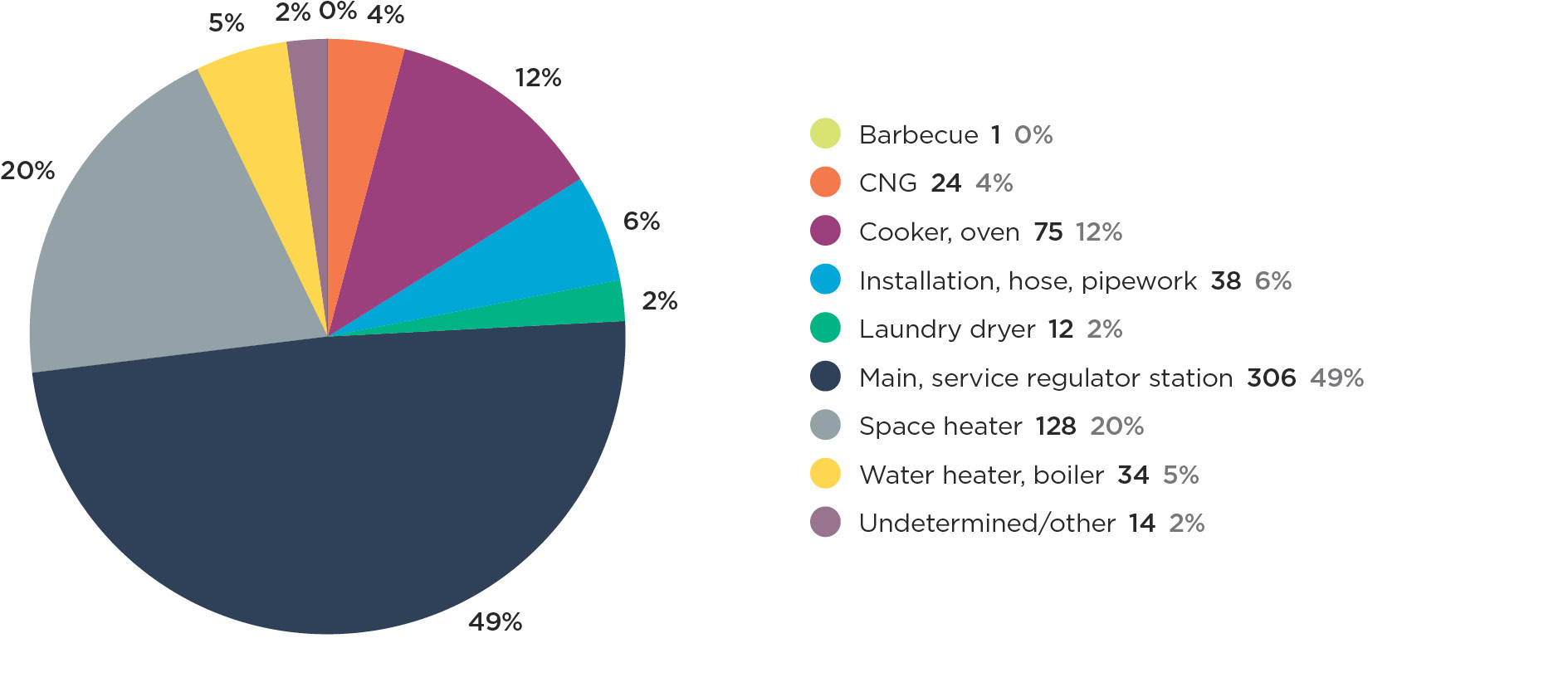
- Approximately half (12 of 25) of the notifiable accidents in the distribution system caused injury to 15 people.
- Approximately half (306) of the 632 non-notifiable accidents reported to Energy Safety involved distribution equipment18 (see Figure 2f) with a gas leak or escape being the outcome in over 80% of cases, and fire in 9% of these cases. Approximately 57% of distribution accidents, including third- party strikes, involved failure to follow correct work practices.
- Approximately one third (32%) or 203 out of the 632 non-notifiable accidents reported to Energy Safety, involved heating equipment or cooking equipment. Fire was the outcome in about three quarters of these accidents.
Cookers and ovens
- 18% (37) of the 207 notifiable accidents and 12% (75) of the 632 non-notifiable accidents involved cookers or ovens. Cookers and ovens were involved in one fatality (in 1999) and injury to 14 people (within 11 injury accidents), see Figure 2g.
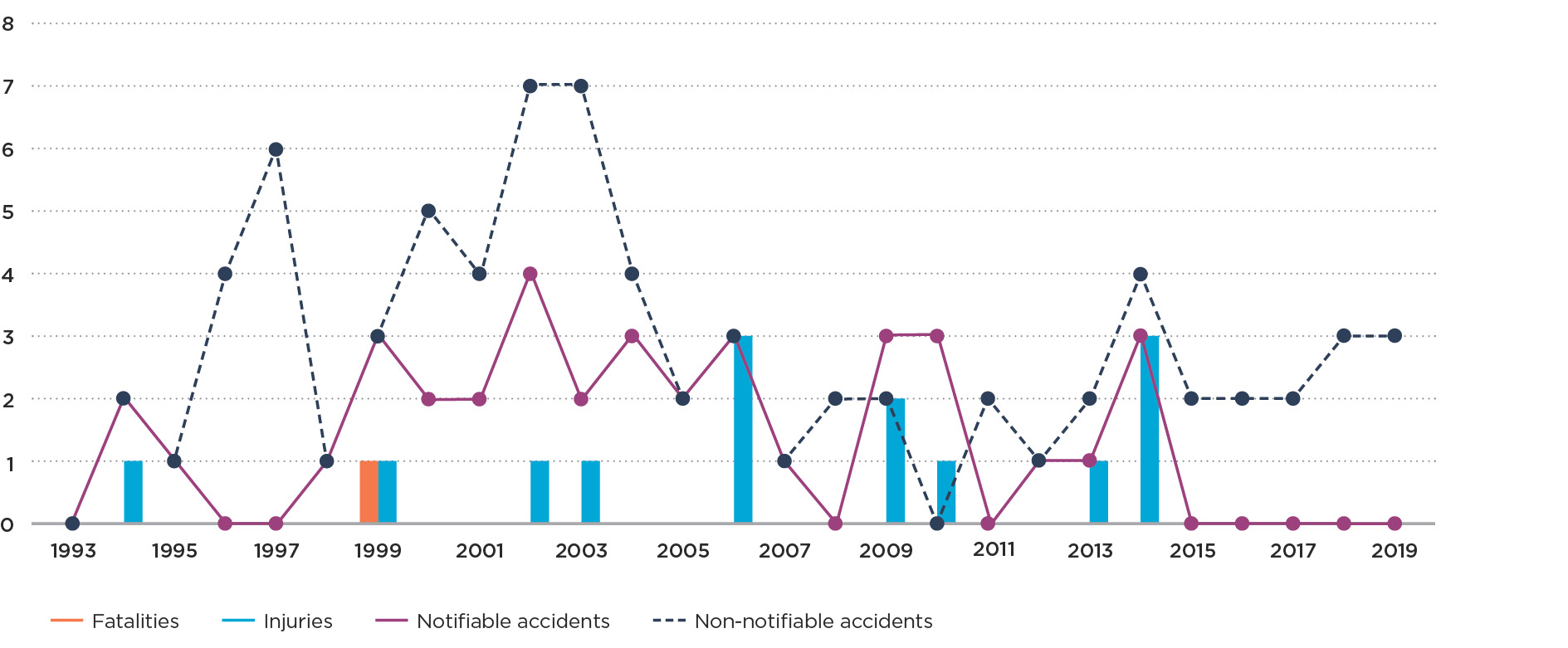
- 19% of the total natural gas notifiable injury accidents involved gas cookers or ovens. In the past 27 years there have been, on average, 1.4 notifiable accidents and 2.8 non-notifiable accidents involving cookers per year.
- 15 (41%) notifiable accidents reported were caused by lack of maintenance and 11 (30%) were caused by assembly, connection, installation and alteration.
- 22 (30%) non-notifiable accidents reported were caused by lack of maintenance, 13 (17%) were caused by operation issue and 18 (24%) caused by assembly, connection, installation and alteration.
Space heaters
- 28% (57) of the 207 notifiable accidents and 20% (128) of the 632 non- notifiable accidents involved space heaters. Space heaters were involved in three fatalities (three fatal accidents) and injury to 13 people (within 12 injury accidents). The last fatal accident involving a space heater occurred eleven years ago in 2007 (see Figure 2h).
- 20% of the total injury accidents involved space heaters in the past 27 years. In the past 27 years there have been, on average, 2.1 notifiable accidents and 4.7 non-notifiable space heater accidents per year.
- 14 of 57 notifiable space heater accidents caused three fatalities and injury to 13 people. Space heaters accounted for 20% of the total non-notifiable accidents.
- 24 (42%) notifiable heater accidents reported were caused by assembly, connection, installation and alteration. 15 (26%) were caused by design19 fault and 13 (23%) were caused by proximity to a combustion products.
- 32 (25%) non-notifiable accidents reported were caused by assembly, connection, installation and alteration. 37 (29%) were caused by design fault and 36 (28%) were caused by lack of maintenance.
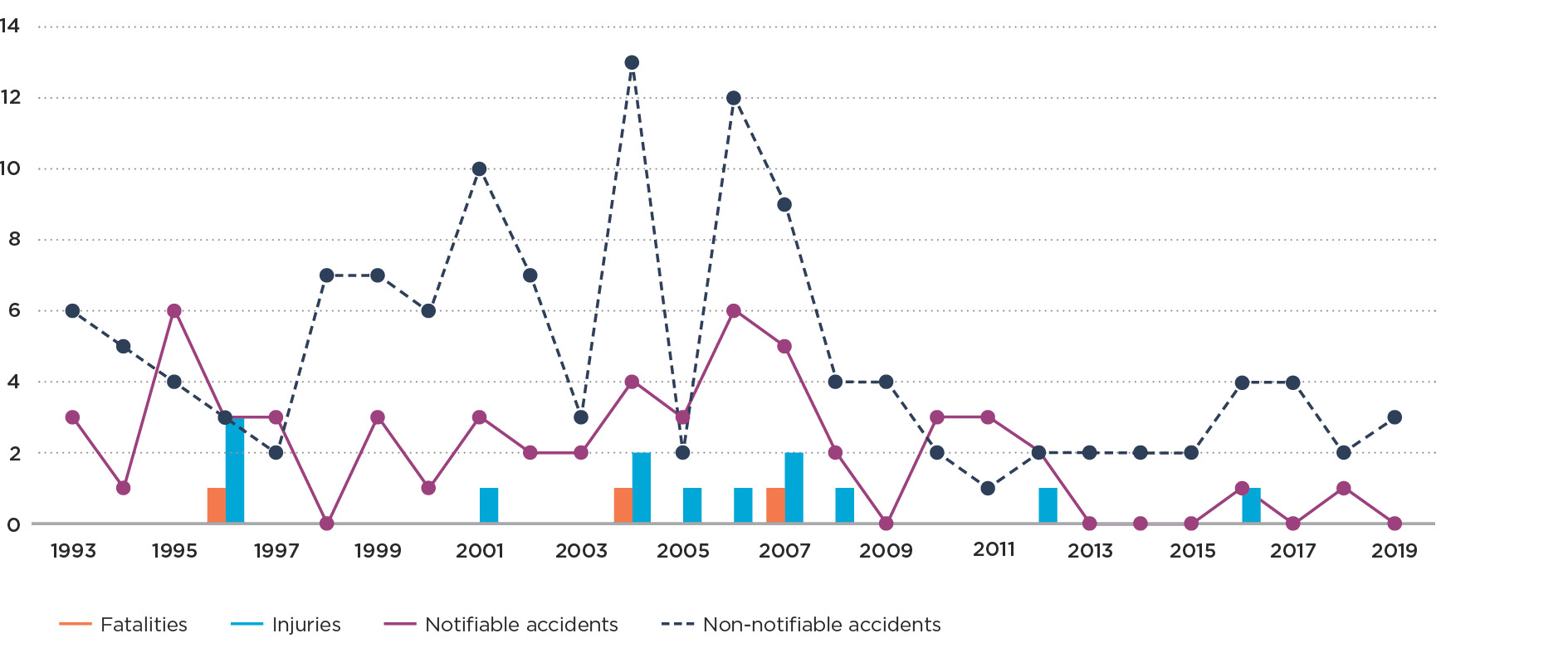
Water heaters and boilers
- 34% (70) of the 207 notifiable accidents and 5% (34) of 632 non-notifiable accidents involved water heaters. Water heaters were involved in one fatality (in 1998) and injury to 19 people (within 16 injury accidents), see Figure 2i.
- In the past 27 years, 26% of the total 72 injuries involved water heaters. There have been, on average, 2.6 notifiable accidents and 1.3 non-notifiable water heater accidents per year.
- 17 (24%) notifiable accidents reported were caused by lack of maintenance and 28 (40%) caused assembly, connection, installation and alteration.
- 11 (32%) non-notifiable accidents reported were caused by lack of maintenance, 9 (26%) were caused by proximity to a combustion products and 9 (26%) were caused by assembly, connection, installation and alteration.
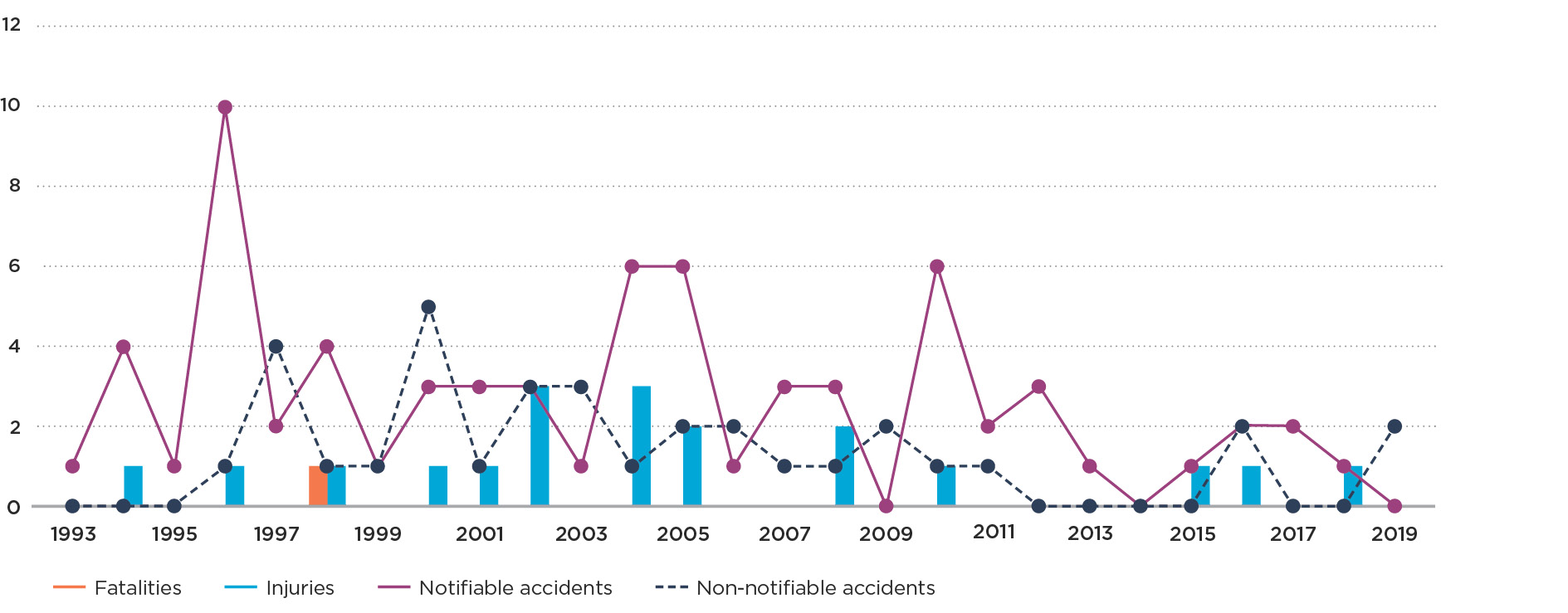
5.0 Liquefied petroleum gas (LPG)
Notifiable and non-notifiable accidents reported to Energy Safety involving liquefied petroleum gas (LPG).
This section includes LPG fuel gas-related accidents of all types, including fire and explosion, whether there were casualties or property loss. All non-notifiable accidents, except for those reported in bulk20 are included in this analysis.
This analysis examines accidents involving members of the public in 2019, and also for the 27 year period from 1993 to 2019. It includes a comparison between the base period (1993–1997) and the current five year period (2015– 2019). In addition to accidents involving members of the public Energy Safety retains an interest in equipment which is reflected in this analysis.
Historically data relating to LPG accidents did not focus on the victims’ age. The recording of data related to the age group of the victims for gas, began with the introduction of an integrated case management system (ESI) in 2008. This section identifies general trends and examines general categories of appliances and other equipment involved in accidents.
LPG is normally used as a fuel for heating, cooking or lighting. However, in a few cases, LPG is deliberately inhaled with serious consequences. (Energy Safety is not the lead agency for investigating incidents that involve the deliberate inhalation of LPG.)
Deliberate LPG inhalation accidents differ from other LPG accidents as the fuel is knowingly misused or handled without any fault in the equipment or fuel. Analysis that included this data might give the impression that LPG is a more dangerous fuel than it actually is in normal use. Deliberate LPG inhalation accidents are not included in the LPG accident analysis.
5.1 Current trends
Examination of notifiable LPG accidents shows that during 2019:
- There were nine notifiable accidents that involved injury or significant property damage. The average annual notifiable accident number is 16.4 over the past 27 years.
- There was not a single fatal LPG accident this year. Over the last 27 years the average number of fatal accidents has been 1.4 per year and 1.6 fatalities per year.
- Six of the notifiable injury accidents injured 12 people in total. One of the LPG accidents (explosion) injured six people. The average for the last 27 years of 7.9 notifiable injury accidents caused an average of 11.1 injuries.
- Three LPG installations and, one each barbecue, cooking appliance and water heater are involved in these injury causing accidents.
- Water heaters and heaters were involved in two-third of these notifiable accidents.
- Eight non-notifiable accidents were reported to Energy Safety. This is less than two-thirds of the annual average number (21.2) over the last 27 years. All except one of these non-notifiable accidents resulted in fires.
5.2 Longer term trends
Observations based on analysis of trends, consequence and frequency for the 27 year period between 1993 and 2019:
- 37 fatal accidents resulted in 44 fatalities.
- Cooking equipment was involved in 13 (35%) fatal accidents resulting in 17 (39%) fatalities.
- Cabinet heaters were involved in 12 (32%) of fatal accidents resulting in 13 (30%) fatalities. Two of these 12 fatal accidents were within the last five years.
- A fatal accident involving fire or explosion is more frequent than a fatal accident involving carbon monoxide poisoning, but carbon monoxide poisoning is more deadly. 23 of these 44 fatalities involved fire or explosion (in 21 accidents) and 20 fatalities involved carbon monoxide poisoning in 15 cases. An average of 1.1 fatalities occurred per fire or explosion accident while an average of 1.3 fatalities occurred for carbon monoxide poisoning accidents.
- There is no clear long term trend to indicate any change in the number of fatal accidents over the last 27 years (see Figure 3a). However, there appears to have been a spike in the number of fatal cabinet heater accidents between 2007 and 2012 compared to the long term trend. Seven of the 12 fatal accidents occurred in the six year period (2007–2012) in comparison to three fatal accidents (four fatalities) in the previous 14 years (1993–2006). There have been two fatal cabinet heater accidents since 2013 (last seven years).
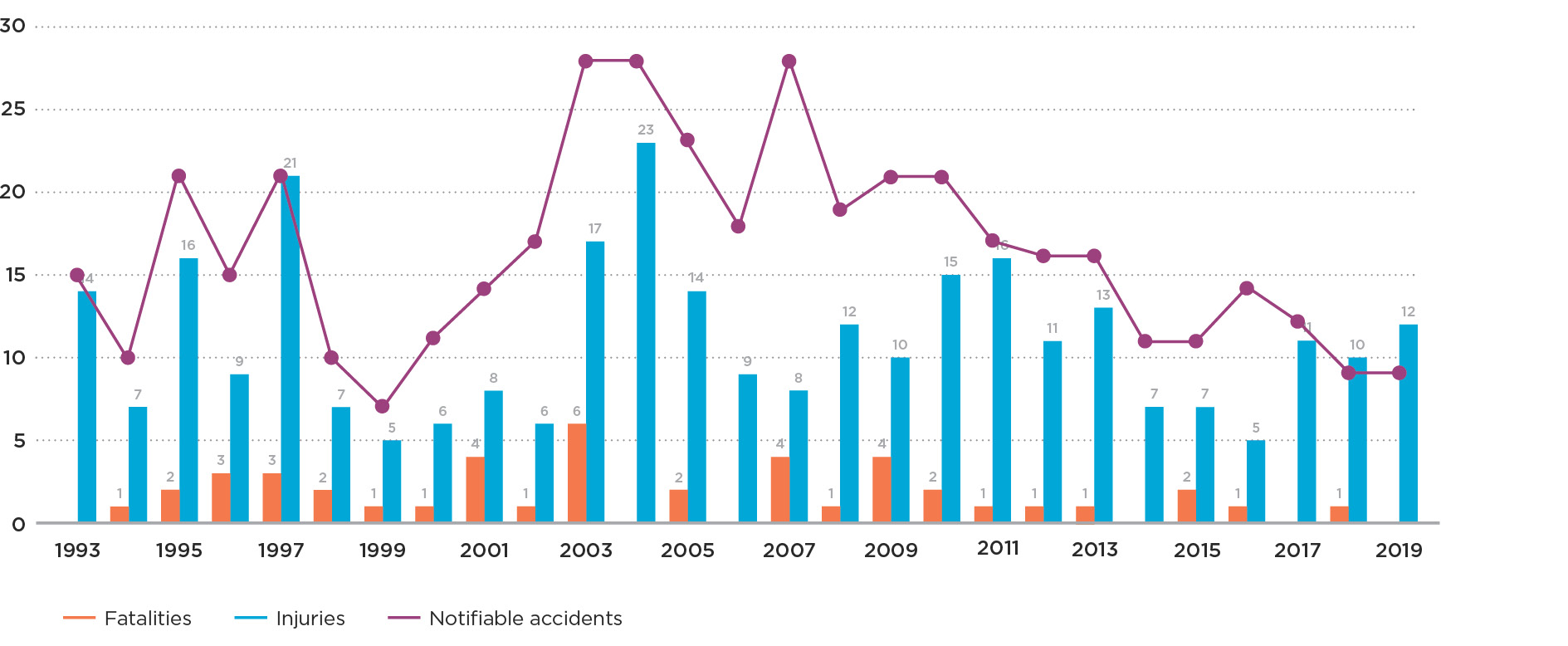
- There have been 442 notifiable accidents. 153 (35%) of the total notifiable accidents and 231 (40%) of the 572 non-notifiable accidents were caused by poor assembly, connection, and installation of or alteration to, an appliance. When analysing gas related accidents it is worth noting that many of these accidents may have had more than one cause attributed to them.
- A total of 209 notifiable injury accidents caused injuries to 299 people.
- Table 8 and table 9 give a more detailed breakdown of LPG casualty and all LPG accidents by equipment type. Cooking appliances were involved in 39% and cabinet heaters in 26% of injury accidents. Two thirds of injuries were caused by these two types of equipment.
- Of the total 442 notifiable accidents, 406 (92%) involved fires or explosions and about half (194) of these fire accidents resulted in casualties.
- A total of 572 non-notifiable accidents were reported to Energy Safety.
- 170 (30%) non-notifiable accidents involved cabinet heaters; 91 (16%) involved containers; 93 (16%) barbecues; and 91 (16%) cooking equipment.
- Over 71% (408) of non-notifiable accidents involved fires or explosions, and about 24% (135) involved gas escaping.
- 21% of the total 1014 notifiable and non-notifiable accidents were reported by Health and Safety Inspectors, and 27% were reported by the New Zealand Fire Service (now Fire and Emergency New Zealand). However, notification by Health and Safety Inspectors has significantly reduced since 2008 (last twelve years) (2.5% of total notification).
| Fatal | Injury | |||
|---|---|---|---|---|
| Equipment type | Consequence21 (frequency) 1993-2019 |
Consequence (frequency) 2015-2019 |
Consequence (frequency) 1993-2019 |
Consequence (frequency) 2015-2019 |
| Cookers and ovens | 17 (13) | 0 (0) | 125 (83) | 18 (11) |
| Cabinet heaters | 13 (12) | 2 (2) | 67 (55) | 7 (7) |
| BBQ | 0 (0) | 0 (0) | 7 (6) | 3 (2) |
| Refrigerator | 6 (5) | 1 (1) | 12 (10) | 1 (1) |
| Containers (refillable) | 4 (4) | 0 (0) | 20 (13) | 0 (0) |
| Canister and canister equipment (mainly cookers) (non-refillable) | 6 (3) | 0 (0) | 54 (31) | 10 (5) |
| Total | 44 (37) | 4 (4) | 299 (212) | 45 (31) |
Table 8: Breakdown of LPG casualty accidents involving members of the public by equipment type
| Notifiable | Non-notifiable | |||
|---|---|---|---|---|
| Equipment type | Accidents22 (per year) 1993-2019 |
Accidents (per year) 2015-2019 |
Accidents (per year) 1993-2019 |
Accidents (per year) 2015-2019 |
| Cookers and ovens | 128 (4.7) | 14 (2.8) | 91 (3.4) | 17 (3.4) |
| Cabinet heaters | 143 (5.3) | 12 (2.4) | 170 (6.3) | 10 (2.0) |
| BBQ | 20 (0.7) | 4 (0.8) | 93 (3.4) | 14 (2.8) |
| Refrigerator | 26 (1.0) | 4 (0.8) | 7 (0.2) | 1 (0.2) |
| Containers (refillable) | 27 (1.0) | 2 (0.4) | 88 (3.3) | 0 (0) |
| Canister and canister equipment (mainly cookers) (non-refillable) | 37 (1.4) | 6 (1.2) | 24 (0.9) | 8 (1.6) |
| Total | 442 (16.4) | 55 (11.0) | 572 (21.2) | 61 (12.2) |
Table 9: Breakdown of LPG accidents involving members of the public by equipment type
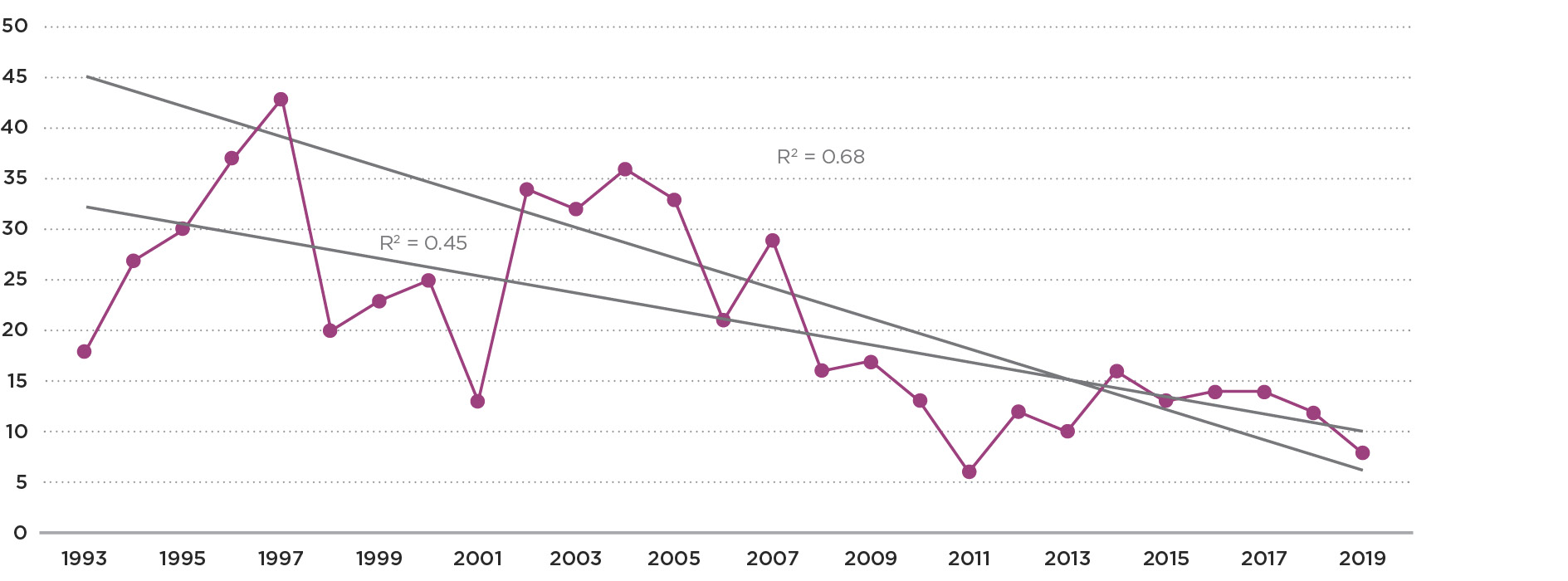
5.3 Causal factors
Table 10 gives the most common causes of LPG accidents over the past 27 years and the last five years. The main causes23 of the notifiable accidents (see Figure 3c) have been:
- incorrect assembly, connection, installation or alteration (35%)
- incorrect operation (15%)
- lack of maintenance (15%)
- operating close to flammable materials (8%).
|
Period |
Period |
|
|---|---|---|
| Main causes |
|
|
Table 10: Factors in notifiable LPG accidents involving members of the public
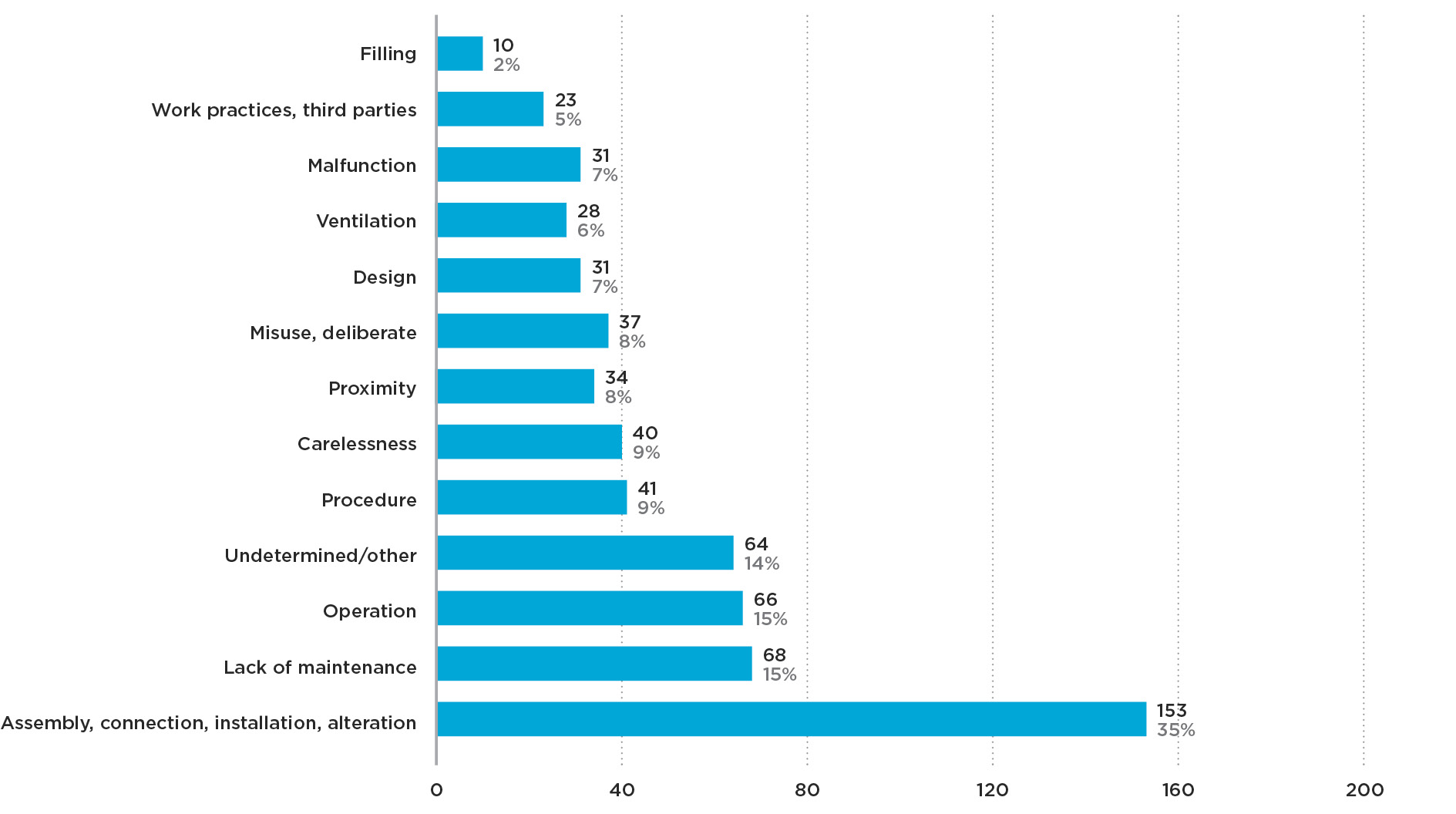
These causes were also the major contributors to non-notifiable accidents reported to Energy Safety (see Figure 3d).
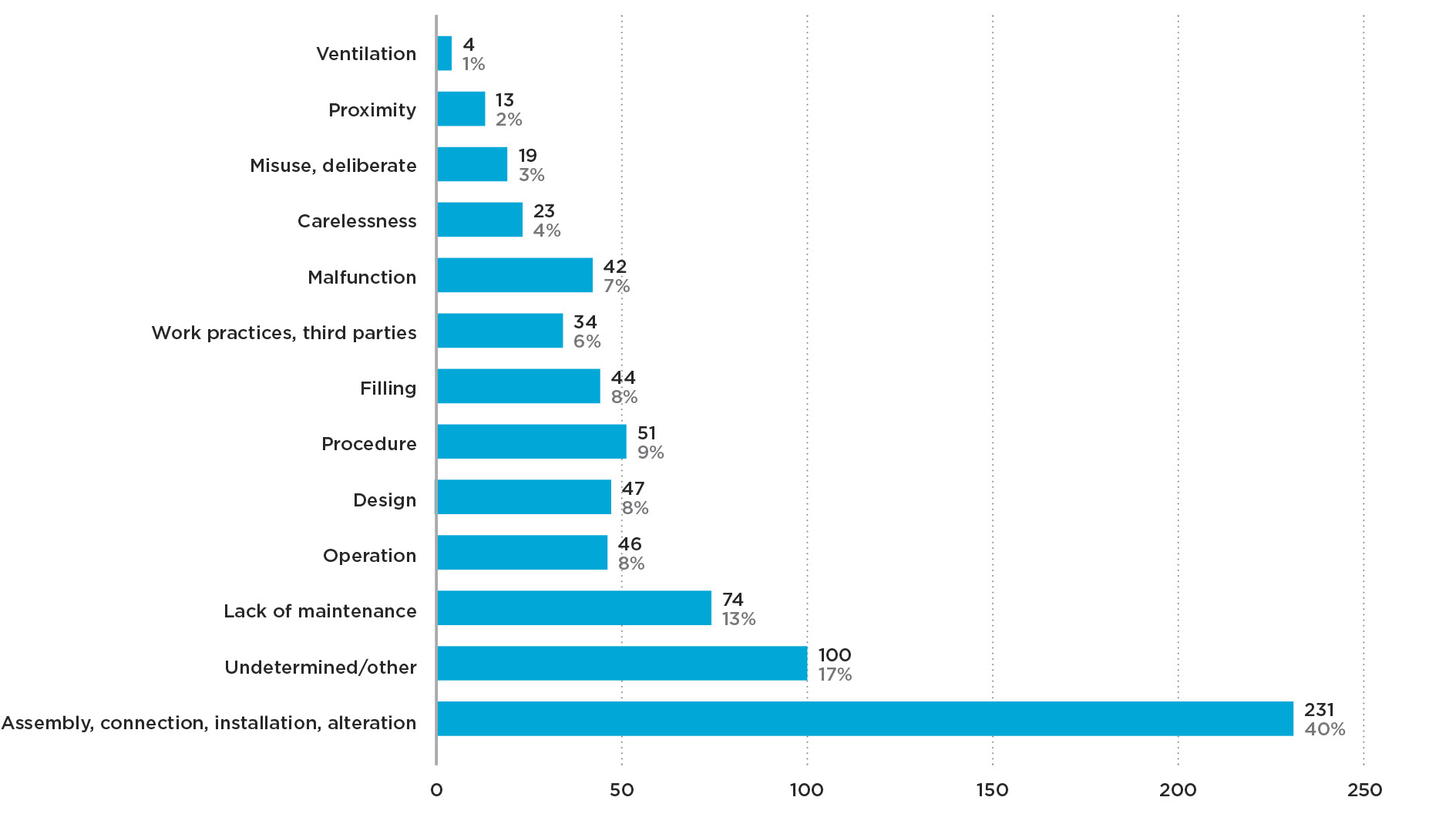
5.4 Equipment
The major contributors to notifiable accidents (see Figure 3e) have been:
- cabinet heaters 143 (32%)
- containers 31 (7%)
- cookers and ovens 128 (29%).
This equipment has also contributed to a significant level of non-notifiable accidents (see Figure 3f). Together these three types of equipment have contributed to about two thirds of the total number of non-notifiable accidents. Barbecues have contributed to 20% of non-notifiable LPG accidents, but for only about 5% of notifiable accidents.
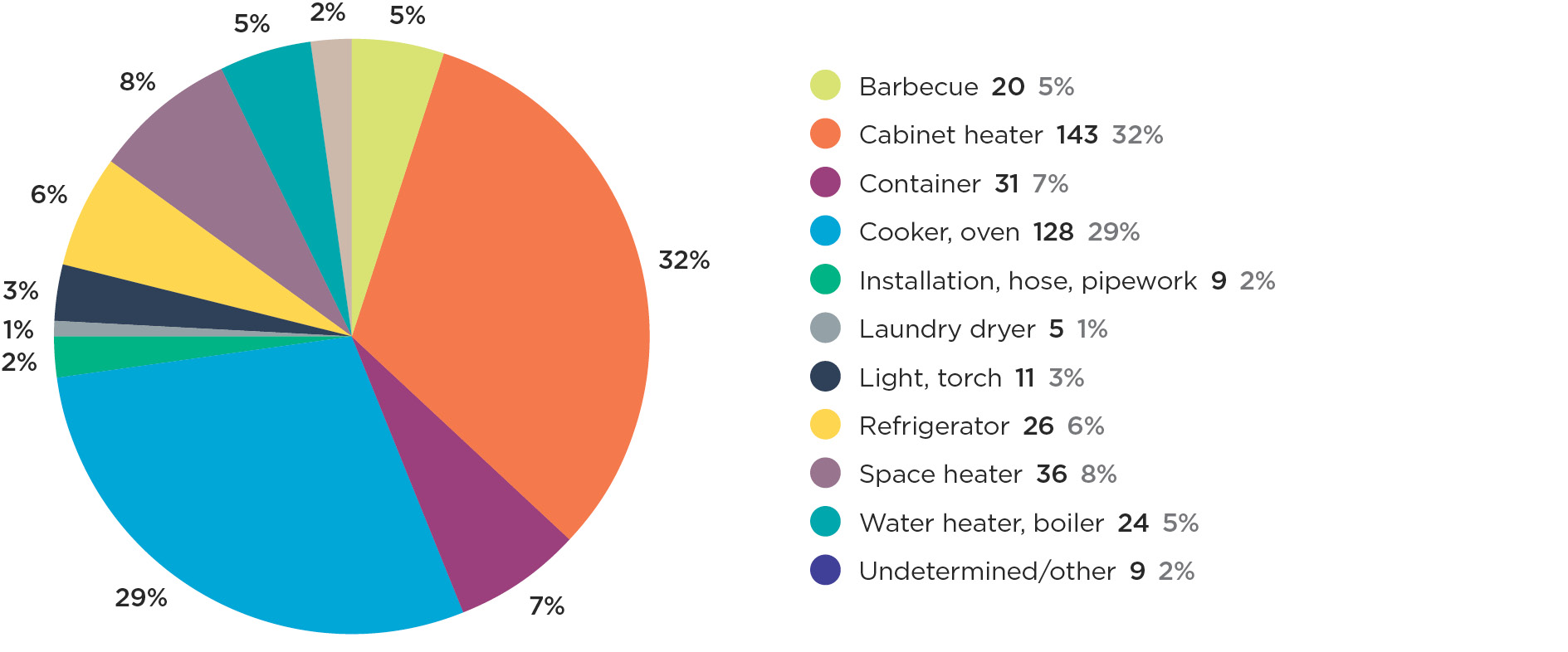
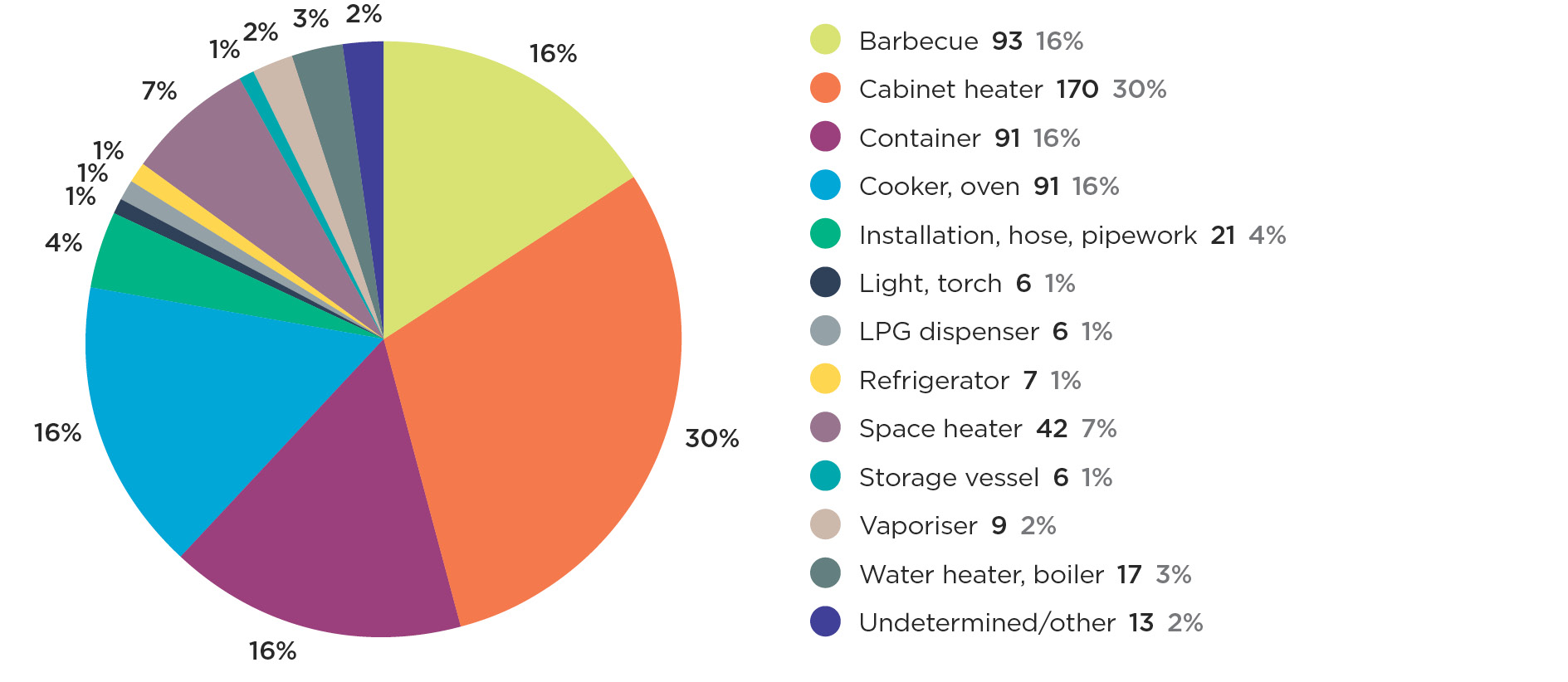
- Gas equipment fuelled by canisters (non-refillable) were involved in 37 notifiable accidents over the last 27 years which is about 8% of the total LPG notifiable accidents.
- Three canister fuelled notifiable accidents caused six fatalities (14% of the total LPG fatalities) and 31 notifiable accidents injured 54 people (18% of total LPG injuries).
- 11% (47) of notifiable LPG accidents (442) occurred in caravans. Ten of these were fatal causing 11 fatalities. 26 of the notifiable accidents injured 40 people, 14% of the total LPG injuries (see Table 11).
| Environment | Consequence24 (frequency) 1993-2019 |
Consequence (frequency) 2015-2019 |
|---|---|---|
| Caravan or campervan | Fatal 11 (10) | Fatal 0 (0) |
| Injury 40 (26) | Injury 4 (4) | |
| Notifiable (47) | Notifiable (6) | |
| Non-notifiable (19) | Non-notifiable (6) |
Table 11: Environment factors in LPG accidents involving members of the public
Cookers and ovens
- 29% (128) of the 442 notifiable accidents and 16% (91) of the 572 non-notifiable accidents involved cookers or ovens. Cookers and ovens were involved in 17 fatalities (13 fatal accidents) and injured 125 people (83 injury accidents), see Figure 3g.
- 39% of total fatalities and 42% of total injuries involved cookers or ovens. In the past 27 years there have been 0.7 fatalities, 4.6 injuries, 4.7 notifiable accidents, and 3.4 non-notifiable accidents per year on average.
- 20 (16%) notifiable cookers or ovens accidents reported were caused by incorrect operation and 51 (40%) caused assembly, connection, installation and alteration.
- 42 (46%) non-notifiable accidents reported were caused by assembly, connection, installation and alteration.
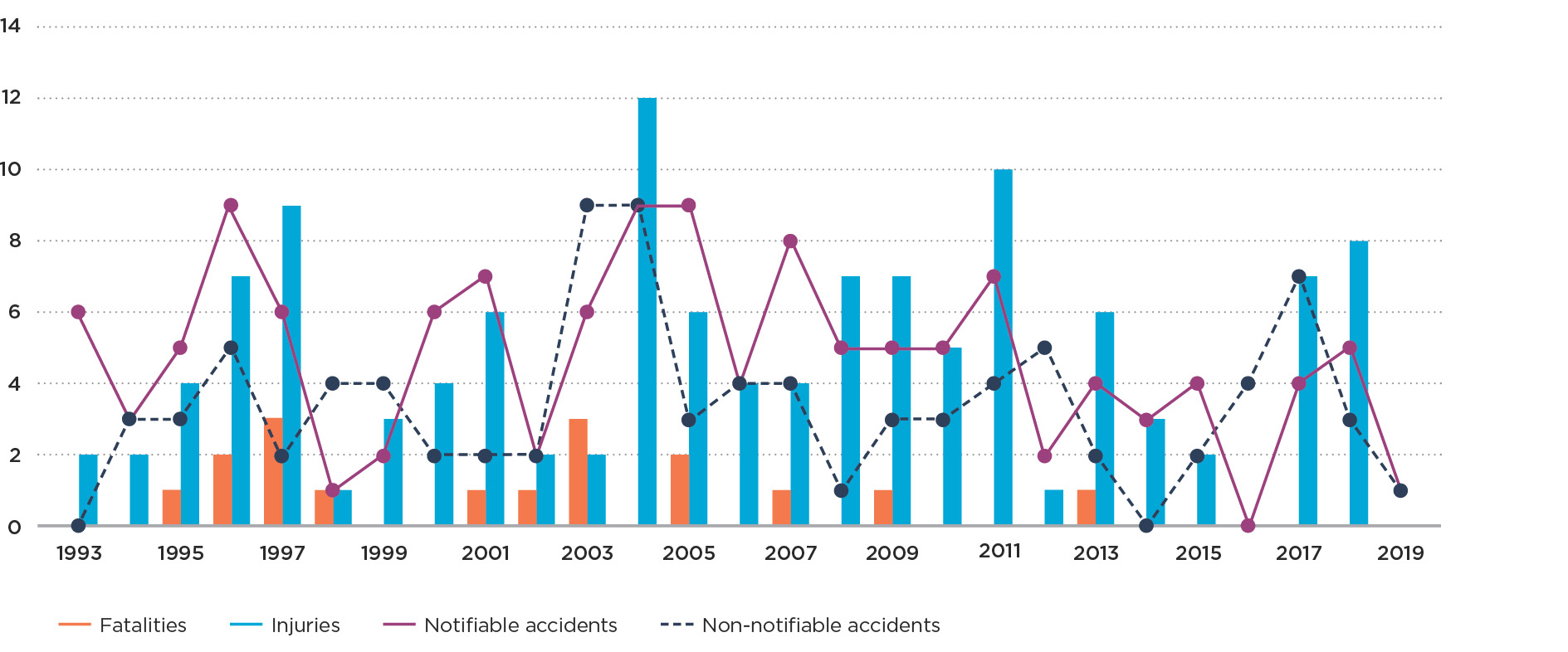
Cabinet heaters
- 33% (143) of the 442 notifiable accidents and 30% (170) of the 572 non- notifiable accidents involved cabinet heaters. Cabinet heaters were involved in 13 fatalities (12 fatal accidents), and injury to 67 people (within 56 injury accidents) (see Figure 3h).
- 30% of total LPG fatalities and 23% of total injuries involved cabinet heaters. In the past 27 years there have been 0.5 fatalities, 2.5 injuries, 5.3 notifiable accidents and 6.3 non-notifiable accidents per year on average.
- 23 (16%) notifiable accidents reported were caused by lack of maintenance, 23 (16%) were caused by proximity to a combustion products and 39 (27%) were caused by assembly, connection, installation and alteration.
- 26 (15%) non-notifiable accidents reported were caused by lack of maintenance and 88 (52%) were caused by assembly, connection, installation and alteration.
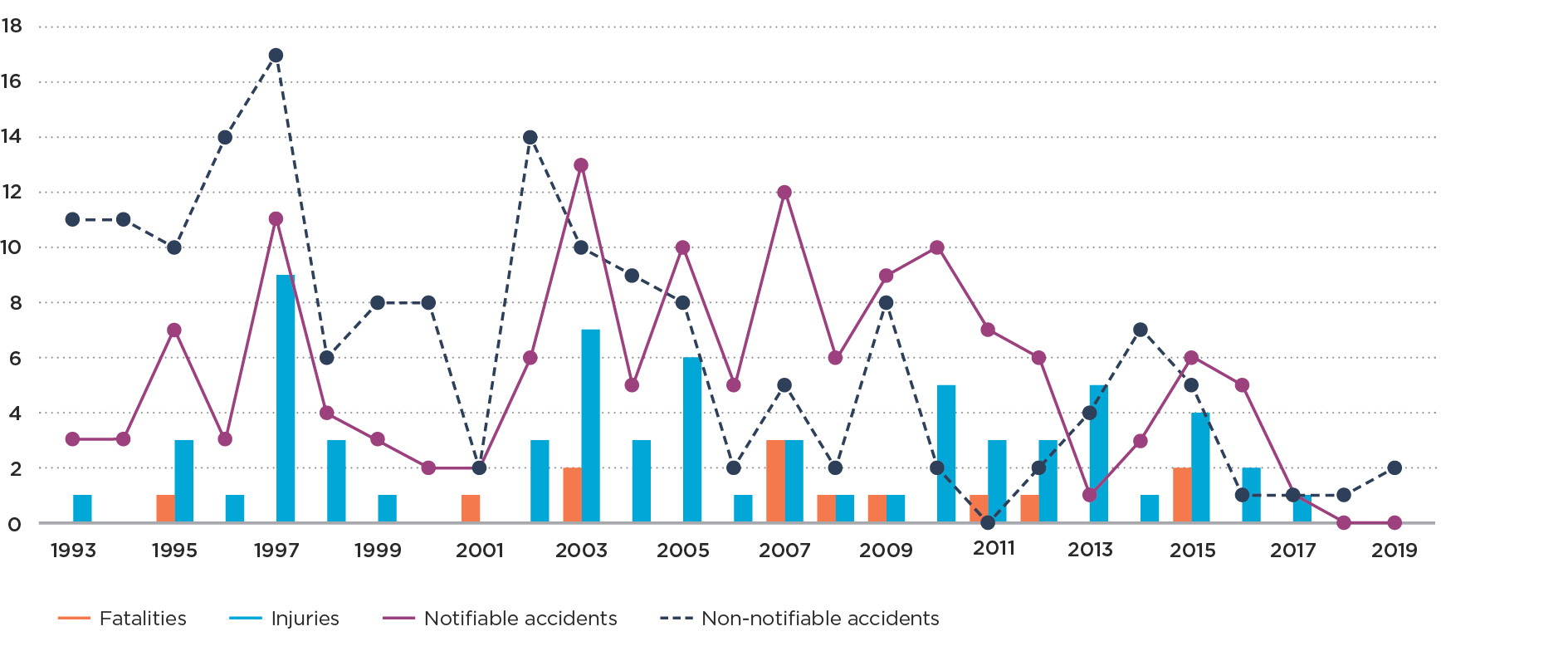
Barbecue
- 5% (20) of the 442 notifiable accidents and 16% (93) of the 572 non-notifiable accidents involved barbecues. Barbecues were not involved in any fatalities, but injured seven people (six injury accidents), see Figure 3i.
- In the past 27 years there have been 0.7 notifiable accidents and 3.4 non-notifiable accidents per year on average.
- 6 (30%) notifiable accidents and 54 (58%) of non-notifiable accidents reported were caused by assembly, connection, installation and alteration.
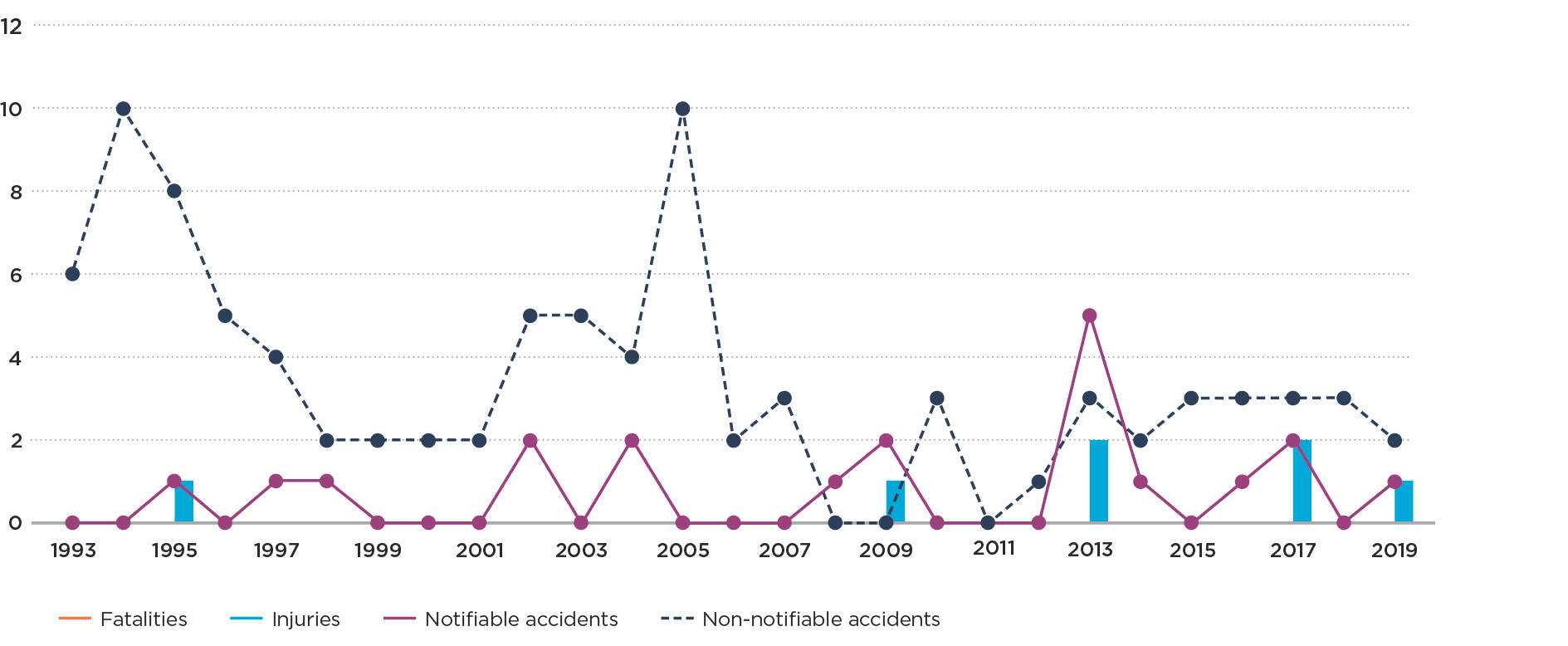
5.5. Environment
Caravans and campervans
- 11% (47) of the 442 notifiable accidents and 3% (19) of the 572 non-notifiable accidents occurred in caravans or campervans. Caravans and campervans were involved in 11 fatalities (10 fatal accidents) and injured 40 people (26 injury accidents) (see Figure 3j).
- 25% of total fatalities and 14% of total injuries occurred in caravans or campervans. In the past 27 years there have been 0.4 fatalities, 1.5 injuries, 1.7 notifiable accidents and 0.7 non-notifiable accidents per year on average.
- 22 (47%) notifiable accidents and 4 (21%) of non-notifiable accidents reported were caused by assembly, connection, installation and alteration.
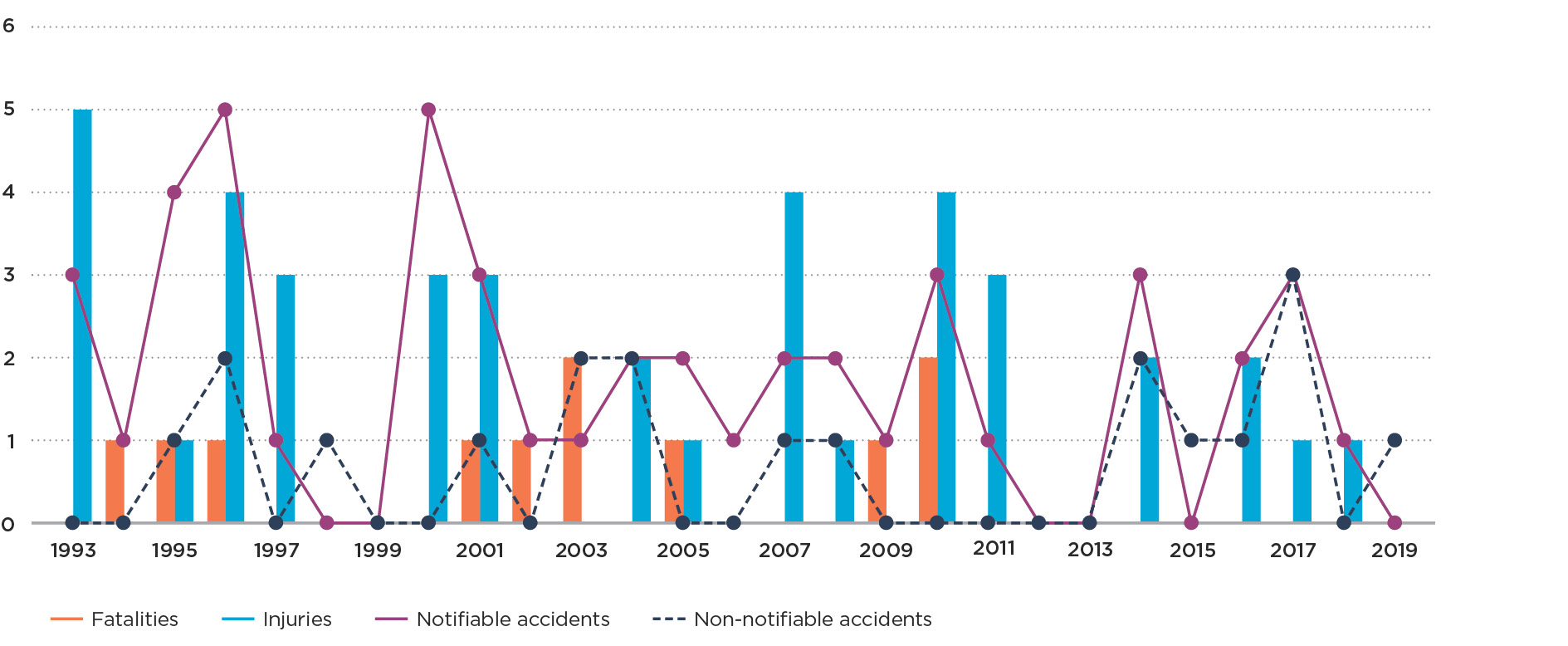
Appendix
Appendix 1: Accidents and accident notification definitions
The occupier or the person in charge of a non-work related accident area is required by law to report to WorkSafe any accidents that are caused by electricity or gas that result in fatalities, serious injuries or significant damage to property.
A notifiable electrical accident has the same meaning as a ‘notifiable accident’ in the Electricity Act 1992. A ‘notifiable electrical accident’ is defined as an accident that is caused wholly or partly by, or involves or affects, electricity, or involves or affects the generation, conversion, transformation, conveyance, or use of electricity, and results in:
- serious harm to any person, or
- damage to any place or part of a place that renders that place or that part of that place unusable for any purpose for which it was used or designed to be used before that accident.
Serious harm means:
- death or injury that consists of or includes loss of consciousness, or
- injury that necessitates the person suffering the injury:
- being admitted to hospital; or
- a notifiable injury or illness as defined in section 23 of the Health and Safety at Work Act 2015 (previously it was receiving medical treatment from a medical practitioner).
A notifiable gas accident has the same meaning as a ‘notifiable accident’ in the Gas Act 1992. A ‘notifiable gas accident’ is defined as an accident that:
- involves the production, conversion, supply, distribution, or use of gas, and results in:
- serious harm to any person, or
- significant property damage.
Serious harm means:
- death or harm that incapacitates, or is likely to incapacitate, the person suffering harm for 48 hours or more
- harm that incapacitates, or is likely to incapacitate, the person suffering harm due to the inhalation of carbon monoxide, or
- a notifiable injury or illness as defined in section 23 of the Health and Safety at Work Act 2015 (previously it was ‘harm of the kinds and descriptions that are serious harm under the Health and Safety in Employment Act 1992’).
A non-notifiable gas accident is defined as an accident that:
- causes property loss, and/or
- causes injury below the threshold defined in the Gas Act 1992, and is involved with what is supposed to be a safe supply or use of fuel gas.
Footnotes
1 - See Appendix for definitions of ‘notifiable’ and ‘non-notifiable’ accidents.
2 - See section 17 of the Gas Act 1992 and section 16 of the Electricity Act 1992.
3 - These electrical accidents relate to direct contact with electricity (that is, ‘shock’).
4 -Because modern reticulated gases do not contain carbon monoxide, this typically involves exposure to harmful products of combustion.
5 - For the purpose of analysis, severity is categorised broadly as ‘fatal’, ‘notifiable – injury’, ‘notifiable – other’ or ‘non-notifiable’.
6 - The definition changed from ‘receiving medical treatment from a registered health practitioner’ to ‘admitted to hospital for immediate treatment’.
7 - The first number represents casualties and the bracketed number represents accidents.
8 - The first number represents casualties and the bracketed number represents accidents.
9 - Domestic installation fittings include switches, plugs and light fittings.
10 - For a certain period in the 1990s Energy Safety received information (notification) of third party strikes in bulk. While all were recorded, in general Energy Safety did not investigate these ‘bulk reported’ and other low level incident events.
11 - Distribution includes mains, services and regulator stations.
12 - The main reason for this drop is the change of responsibility for reporting and investigating workplace accidents.
13 - Many accidents may have had more than one cause attributed to them.
14 - Incorrect work includes assembly, connection, installation and alteration.
15 - Incorrect work includes incorrect assembly, connection, installation and alteration.
16 - The first number represents casualties and the bracketed number represents accidents.
17 - The first number represents accidents and the bracketed number represents accidents per year.
18 - This includes mains, services, regulator stations and meters.
19 - This includes engineering problems with structure/material specifications or plans. Also clear ergonomic problems (making misuse or operation error likely).
20 - For a certain period in the 1990s Energy Safety received information (notification) of minor incidents in bulk. While all were recorded, in general Energy Safety did not investigate these ‘bulk reported’ and other low level incident events.
21 - The first number represents casualties and the bracketed number represents accidents.
22 - The first number represents accidents and the bracketed number represents accidents per year.
23 - Many accidents may have had more than one cause attributed to them.
24 - The first number represents casualties and the bracketed number represents accidents.
Last updated